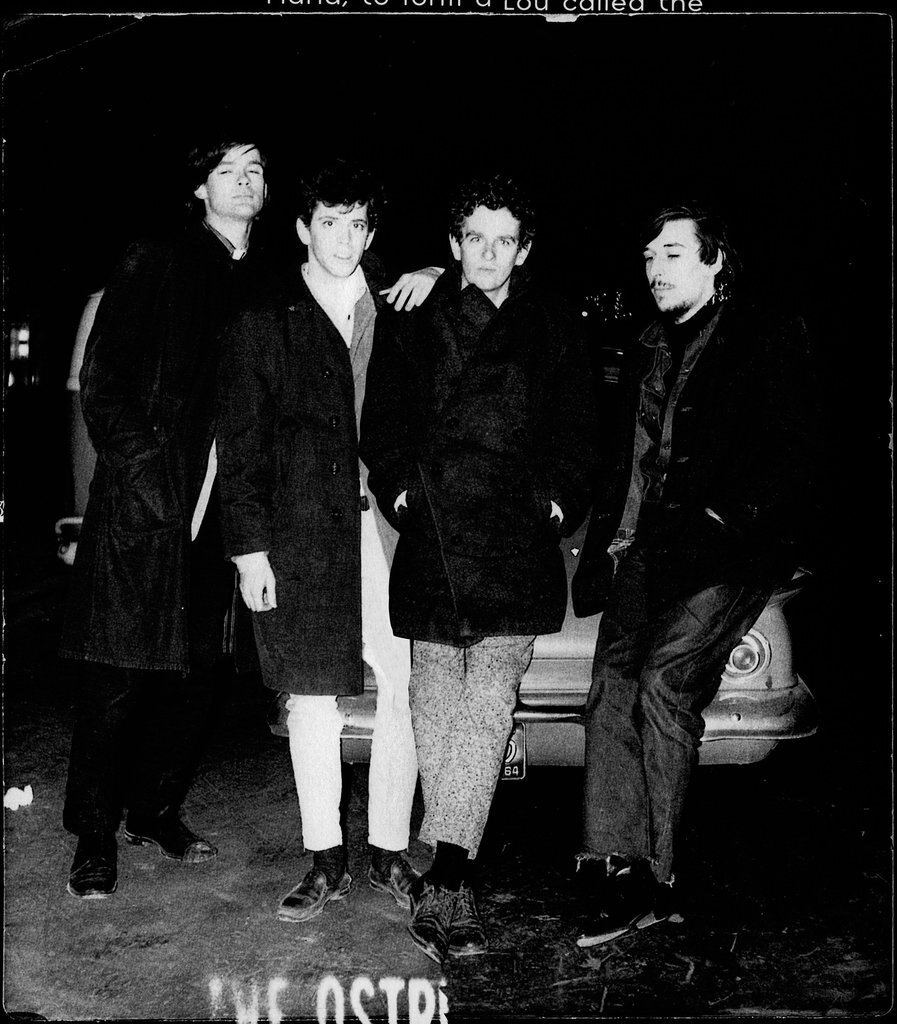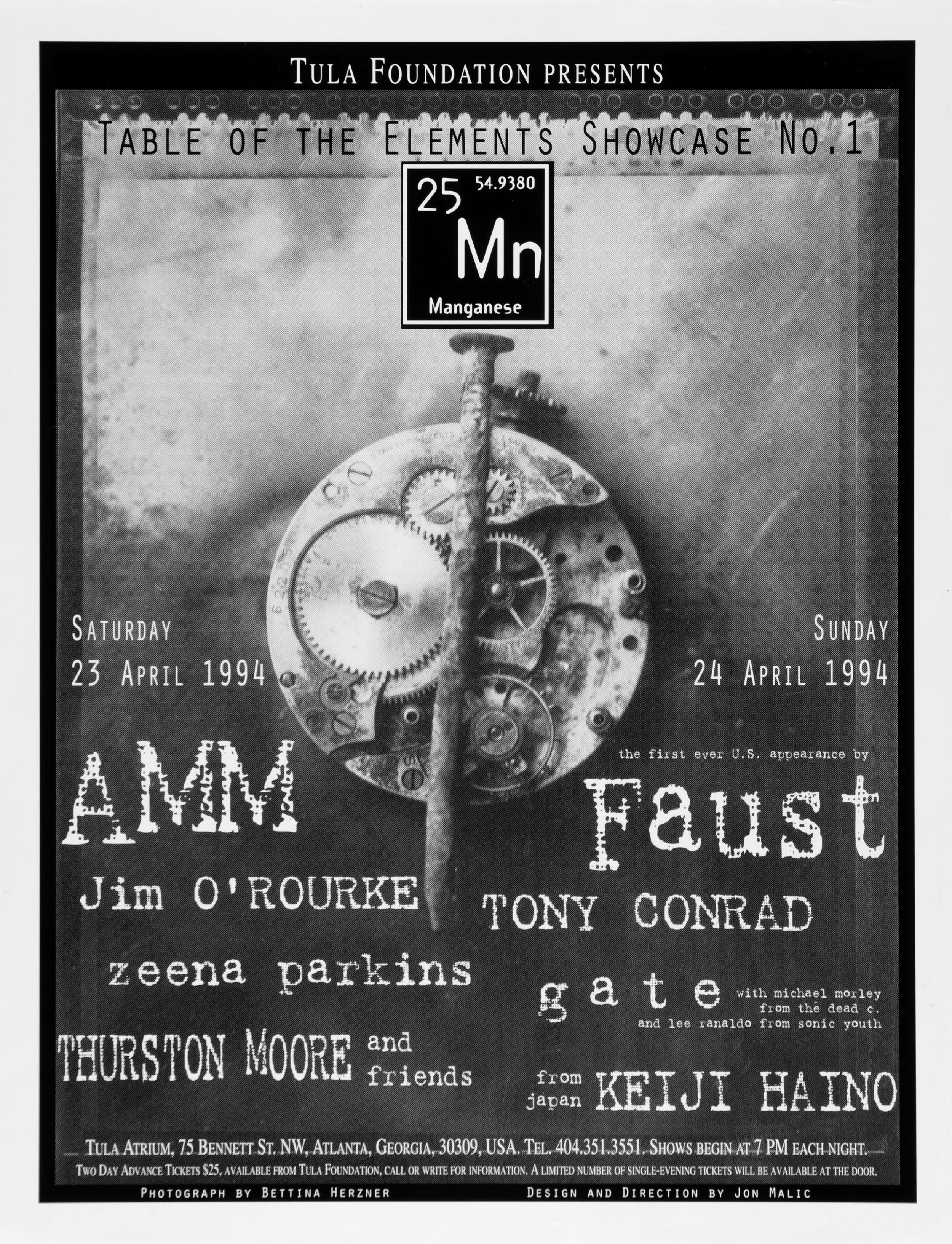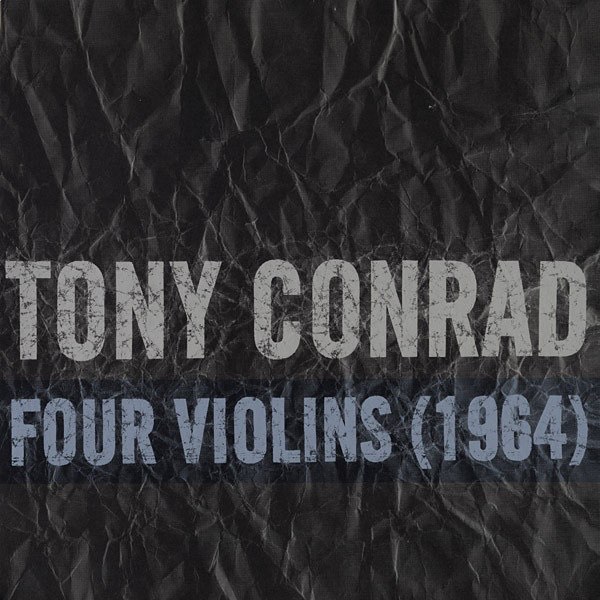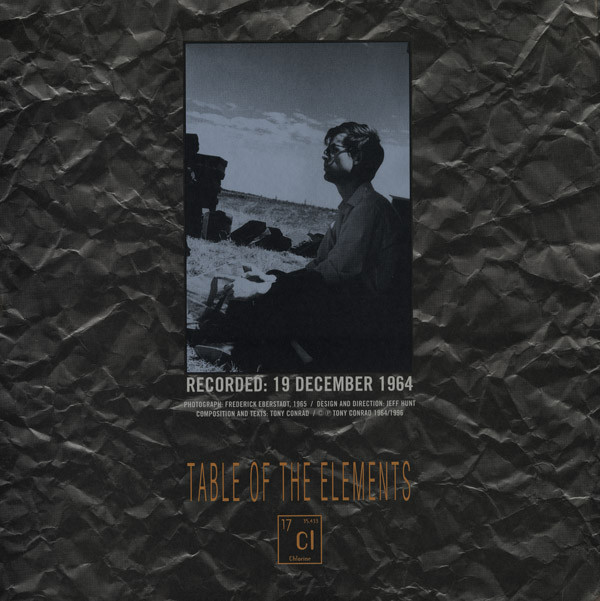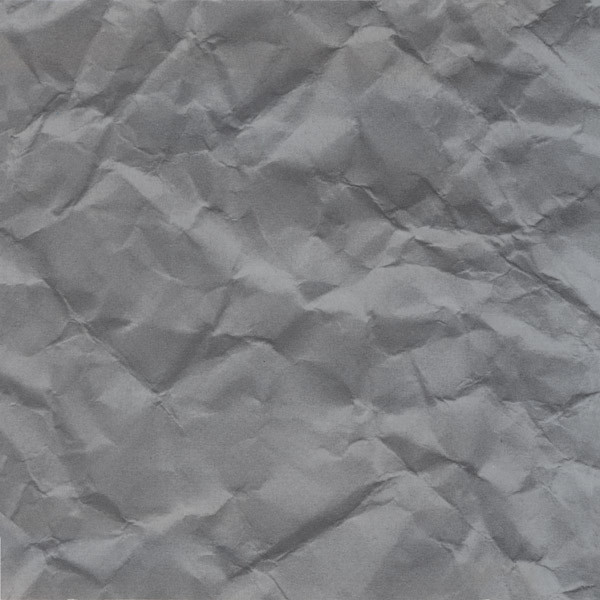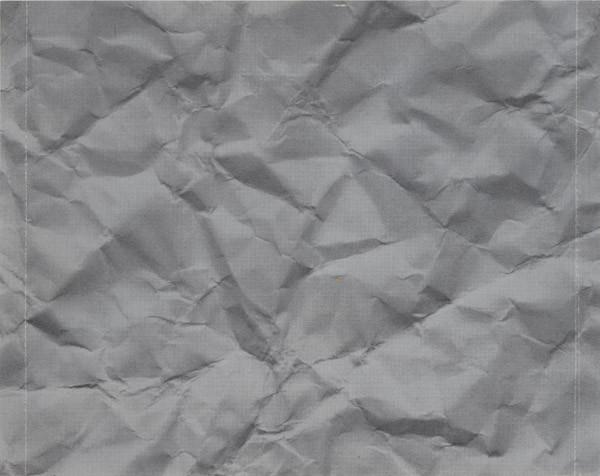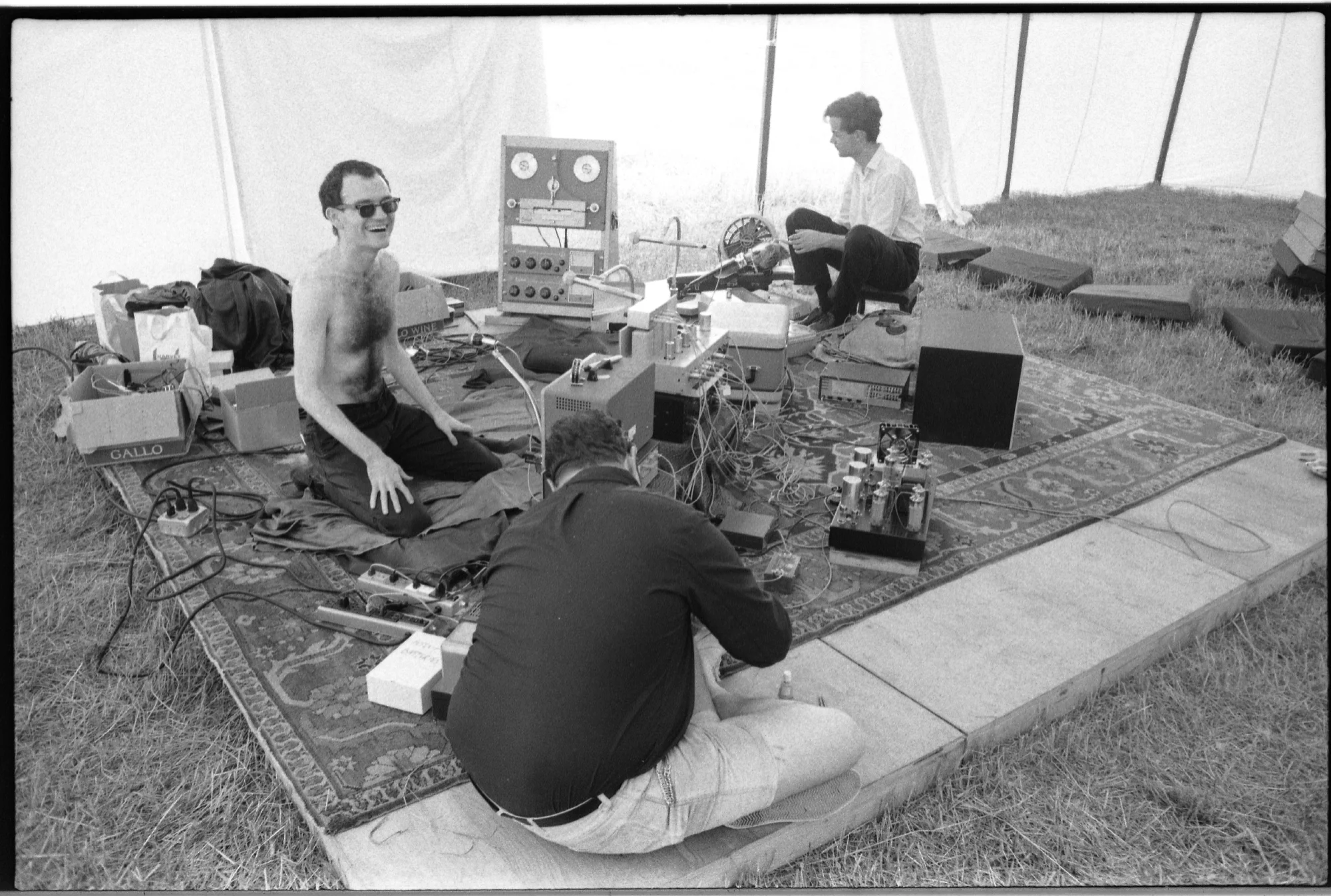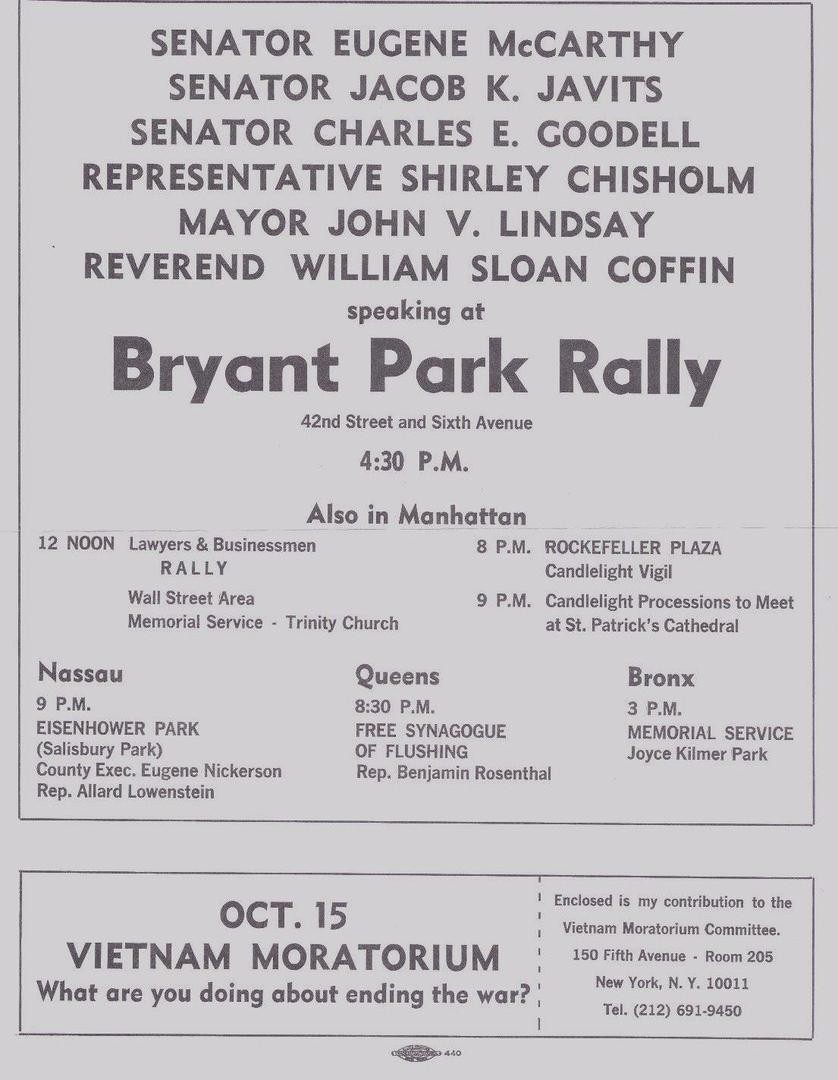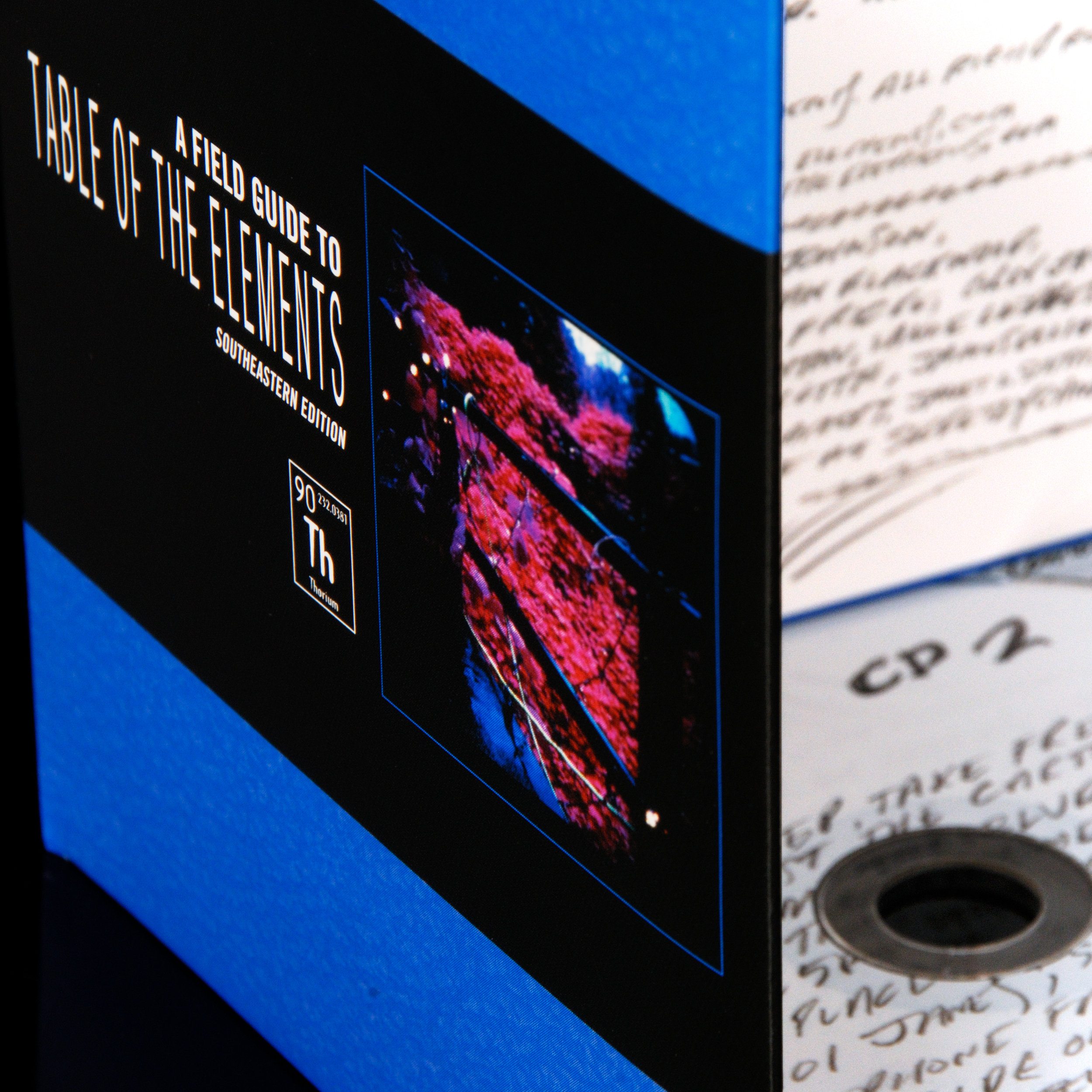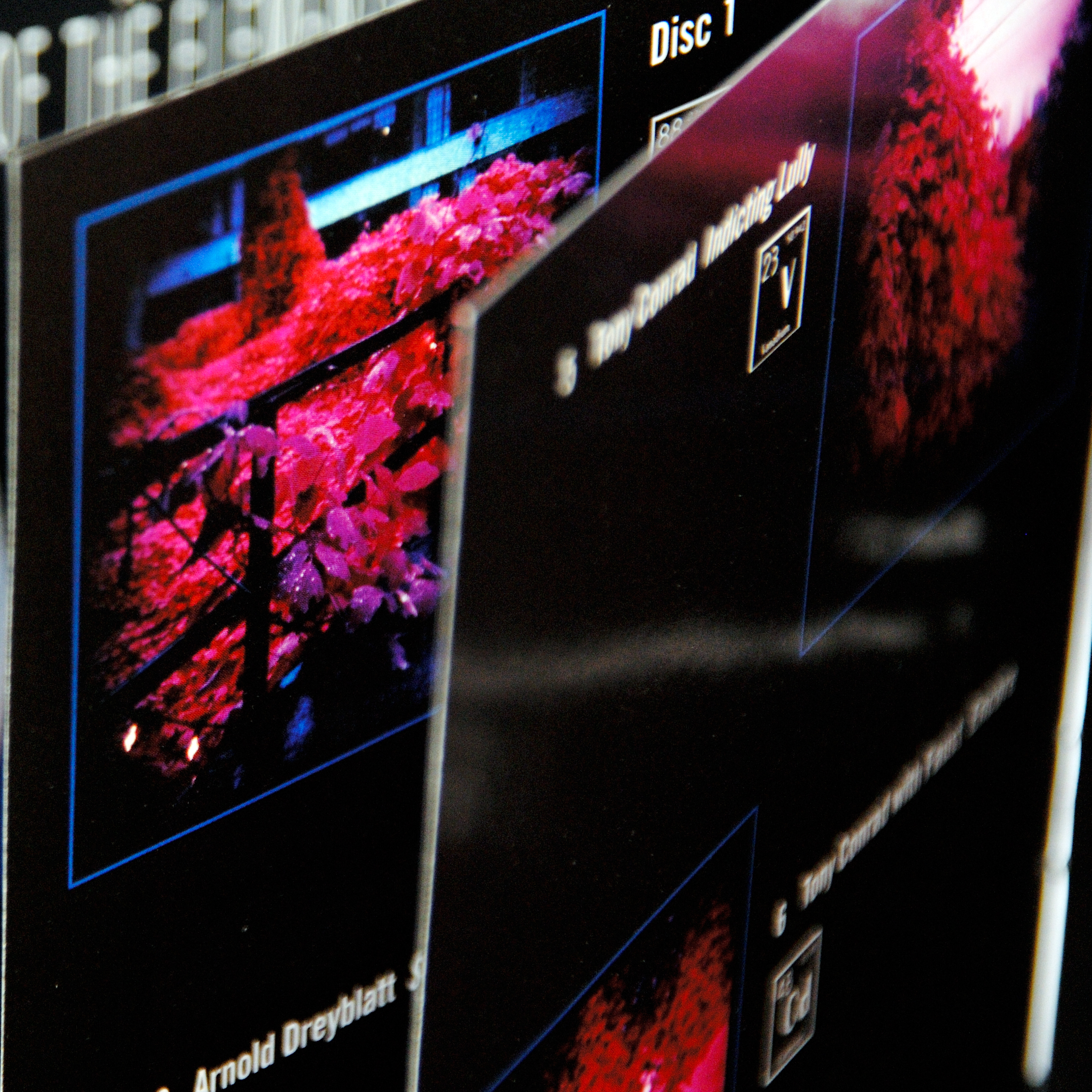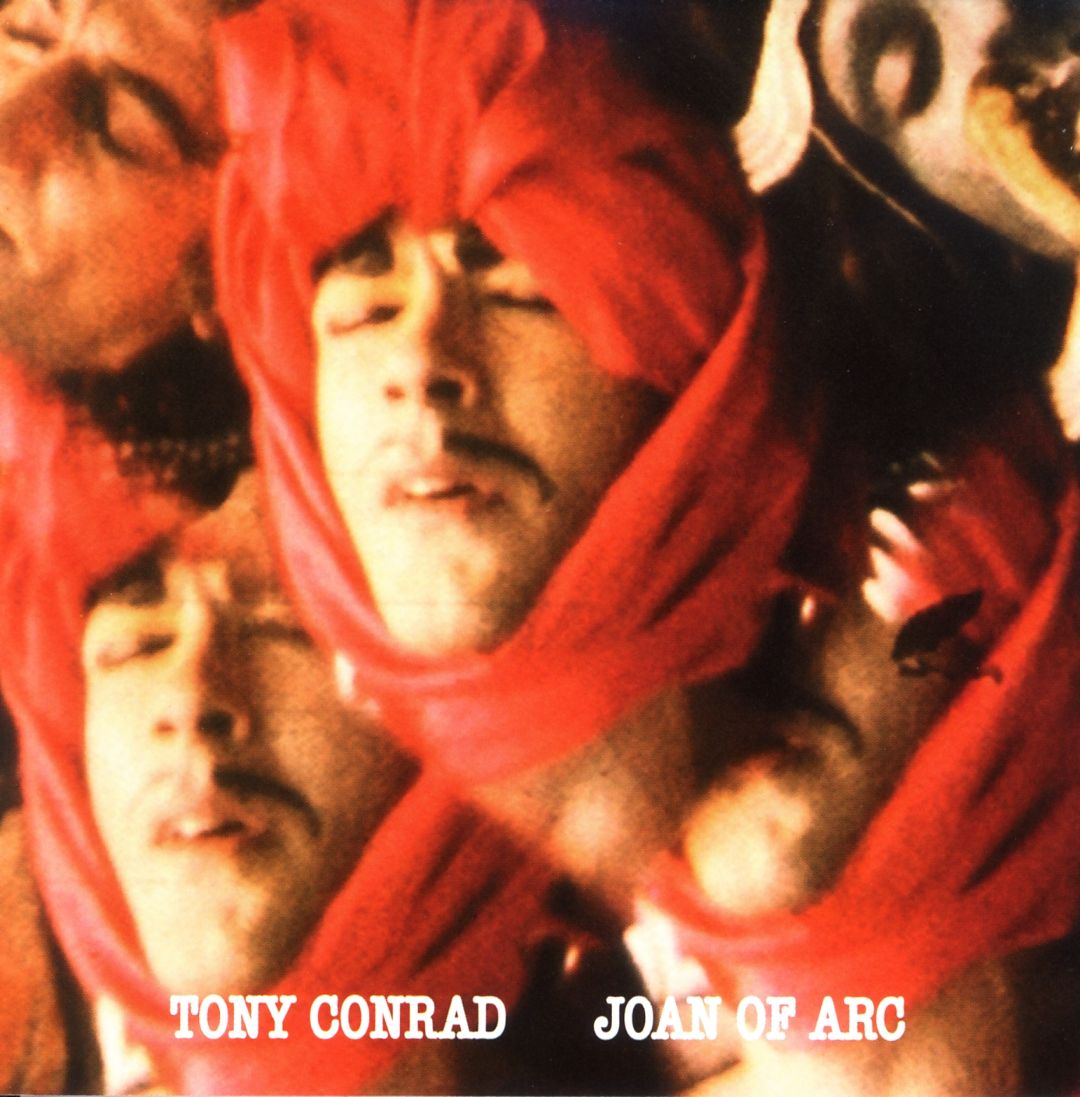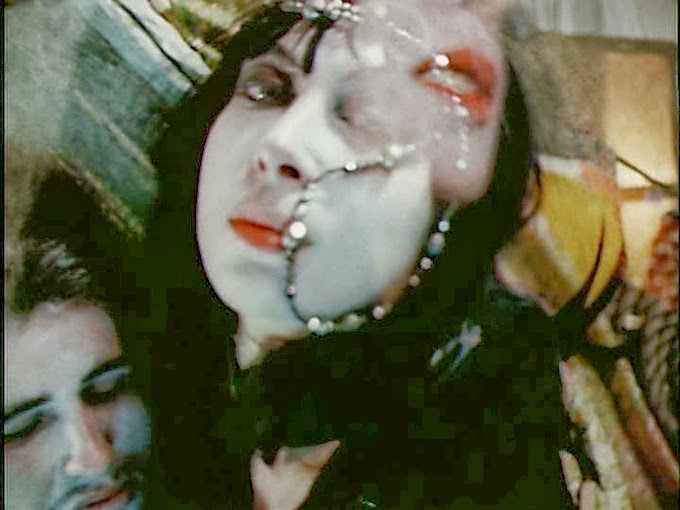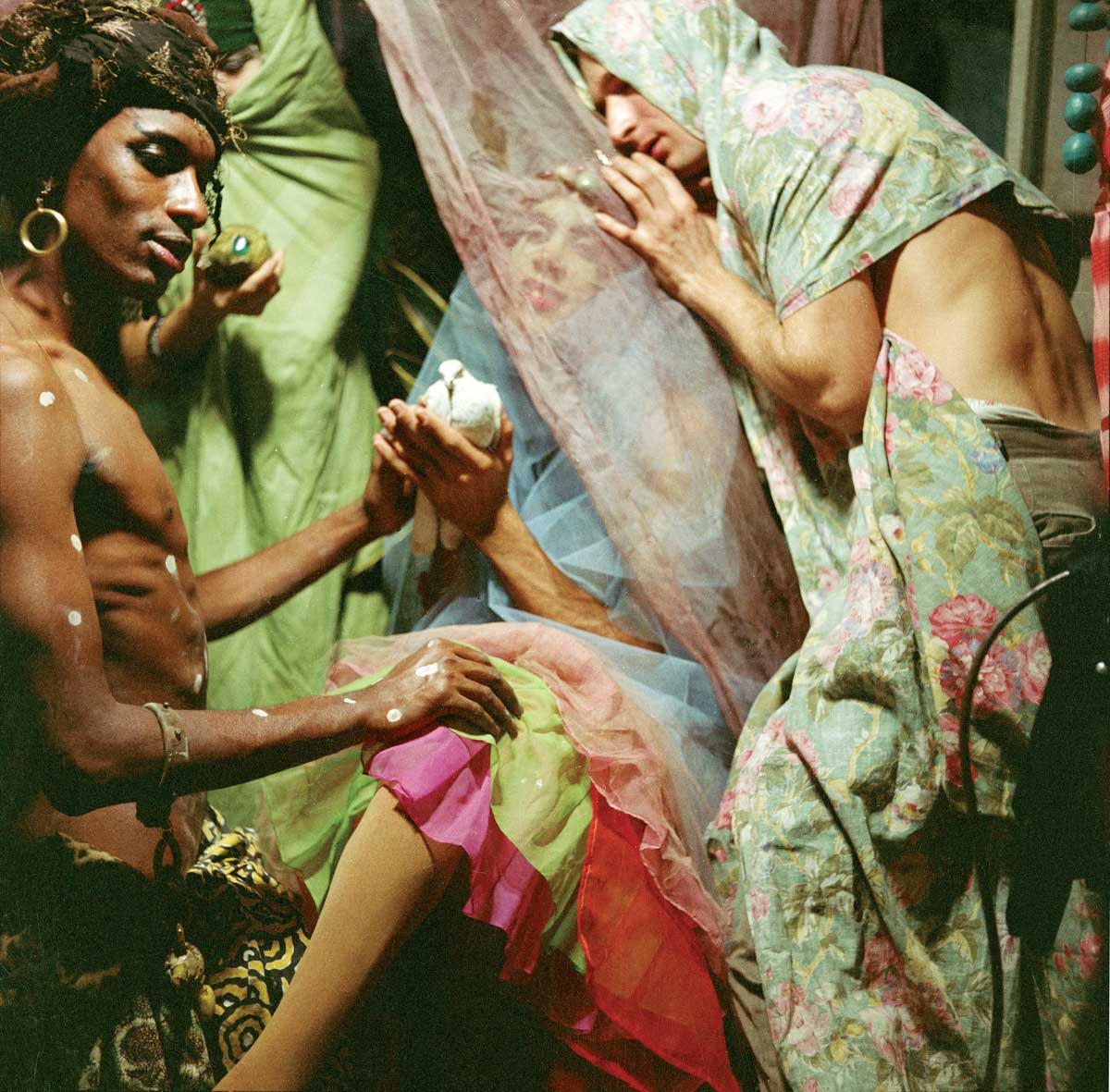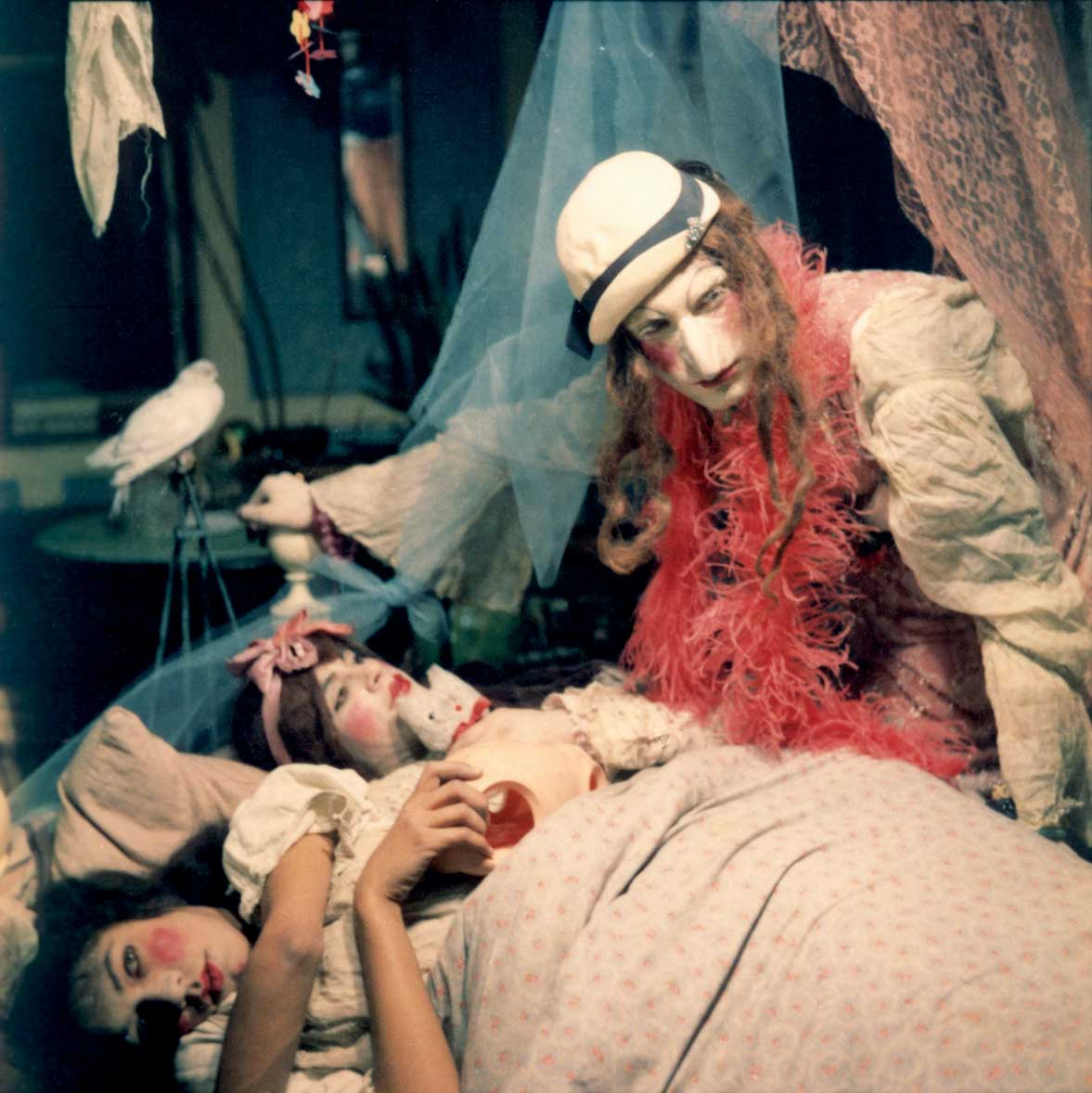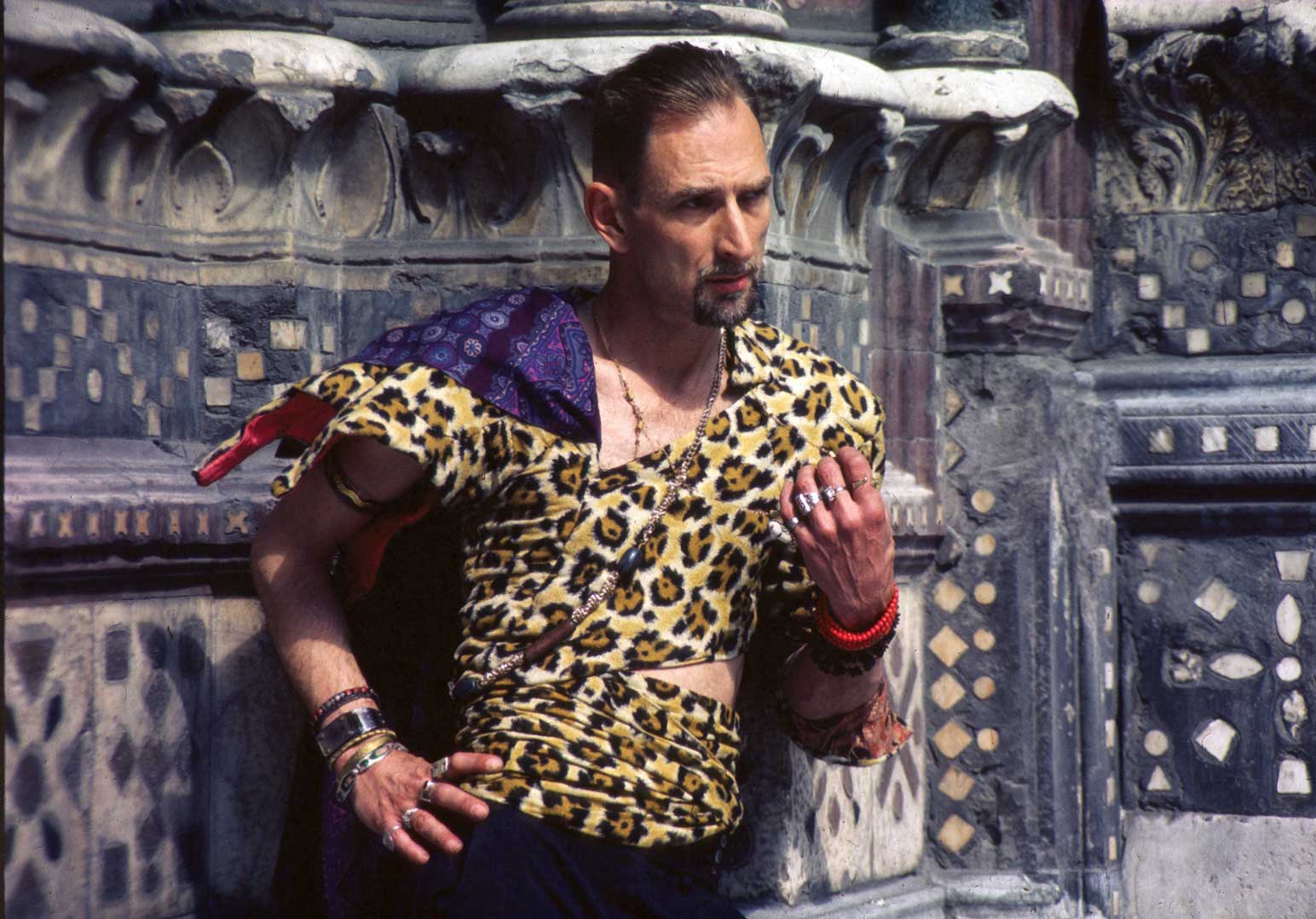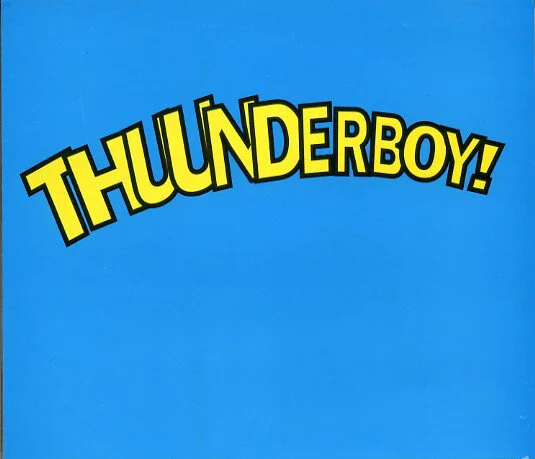The Primitives, a precursor to the Velvet Underground, in 1965. From left, Mr. Conrad, Lou Reed, Walter DeMaria and John Cale. Credit...via Tyler Hubby
"People like Conrad, so free of many of the conventional ideas and restraints that often just end up being selling points, reminds me that as down as you want to feel is just how much you want to deny the fact that there have been brilliant people in every decade, including this one, pushing in every possible way against mediocrity, conformity and ignorance. When in doubt, go to the museum, the gallery, the record store, anywhere you can find art. The world might not change, but yours could."
Henry Rollins, LA Weekly
“They mixed it too soft and made me sound like a hippie.”
Original photobooth image, 1965. This image ©Table of the Elements Archive
Tony Conrad with Faust
Outside the Dream Syndicate
1993
Table of the Elements
[Lithium] TOE-CD-3
Compact disc
Tony Conrad with Faust
Outside the Dream Syndicate: 10th Anniversary Edition Box
2002
Table of the Elements
[Lithium] SWC-CD-302
2x compact discs, poster, sticker, 16-page book, 96-page catalog, foil stamp, enclosure
Tony Conrad with Faust
Outside the Dream Syndicate: 10th Anniversary Edition
2004
Table of the Elements
[Lithium] SWC-CD-302
2x compact discs sticker, 16-page book, foil stamp
Double CD in deluxe, limited-edition packaging
Includes unreleased material from the original 1972 sessions
Digitally remastered for this release
Features new liner notes by Rolling Stone senior editor David Fricke
"Out-machines Metal Machine Music."
Creem
"Whether you heard it in 1972, or in the present time, it still kicks infinitely. At its most basic, this an early fusion of the classical and avant-garde with the more rock and pop sensibilities of the day, something not seen since the Beatles' Stockhausen riff, 'Revolution #9,'and scarcely since. It couples minimal tones with an almost James Brown-like bass-kick bottom and relentless thrust. The results are prodigious, prophetic, powerful. To this day there's still nothing quite like its primitive, otherworldly chug ... Together [Conrad and Faust] elevate into endless crescendos and cascades of holy sound, floating on an Om-like soundwave. Whether an initiate or a first-timer, this is something quite timeless."
Andy Beta, Luna Kafe
"Conrad invents a new musical language ... unbearably intense and gloriously ecstatic."
The Wire
"A terribly exciting, endlessly fascinating genre-bender ... absolutely exhilarating."
The Yale Herald
"Behold the glacier with an amplified pulse!"
Tower Pulse
"Monumental ... Just follow your bliss."
Philadelphia Weekly
"Top-5 Reissues of 2002."
Washington City Paper
"Top-10 Reissues of 2002."
The Wire
An old Zen koan comes to mind; delivered through the lesser hands of seekers and compilers, beats and Deadheads, the New Age-- but surely, I imagine, of wise and noble provenance somewhere back. A flag flapping in the gale sparks an argument between two monks on the nature of things. The first declares that the flag is surely moving. The flag is still, counters the other, it is the wind that is moving. Sure enough, where an insoluble paradox appears, the wandering master is not far behind. Which is it, ask the monks, is the flag moving or is the wind moving? Neither, replies the master; mind is moving.
Fair enough. Take it, like any wisdom, with a grain of salt, but it springs to mind. Not because Tony Conrad sees still air and a flapping flag, or because Faust occupy a world of volatile weather, but just because, for a moment in Outside the Dream Syndicate, one forgets what exactly is moving and what is standing still.
Here's what we know: in October 1972, at a hippie commune in WŸmme in southwestern Hamburg, a German art-rock collective bred on the stringent drone and skag-pop of the Velvet Underground hooked up with the young composer who gave that band its name-- or rather, who handed Lou Reed the sadomasochism exposŽ whence the band derived its name. Tony Conrad and the members of Faust collaborated for three days on an album that would be released the following year in England and would tank immediately thereafter. The musicians did not communicate or collaborate throughout the following two decades.
Minimalism is unquestionably the wrong word; I prefer asceticism. Anyone familiar with the Zappa-like hysteria of Faust's first album or the searing kosmische of IV must imagine the sheer force of self-denial at work in implementing Conrad's vision: to have a deep base note tuned to the tonic on Conrad's violin and to have the drummer "tuned" to a rhythm that corresponded to the vibrations. Minimal in design, I suppose, but catastrophically huge in execution.
"From the Side of Man and Womankind" opens in dead motorik, the usually nimble percussive battery of bass guitarist Jean-HervŽ Peron and drummer "Zappi" Diermaier, stalled out to a hollow thud-- like the heartbeat of a machine. Conrad's violin bleats mournfully, endlessly; rising, breathing, sighing, screaming, but without ceasing: relentless. Faust resisted. Peron's second bass note, inserted against Conrad's wishes, adds a spring and thrust to the proceedings. Zappi's odd cymbal crash shatters like punctuation in a prayer. Faust producer Uwe Nettelbeck dulled the serrated violence of Conrad's violin, somehow rendering slow murder into long caresses. "The Side of Man and Womankind" runs like a conveyor belt through fog: going without moving, advancing, standing still.
"From the Side of the Machine" is oddly less mechanical than its counterpart. A half-hour in length, like "Man and Womankind", the "Machine" side ruminates with muted psychedelia: serpentine bass, ceremonial percussion, the purr and roar of Rudolf Sosna's humming synthesizer, Conrad's violin passing high above like an electrical storm in the upper air. There is a predatory quality to the "Side of the Machine": an encircling peril, a certain restlessness above and behind. Mind moves, as if hunted.
The Thirtieth Anniversary Edition of Outside the Dream Syndicate adds a second disc of material. Two brief tracks-- both named with the young death of former Dream Syndicate comrade Angus Maclise in mind-- offer the remaining fragments of those three days at the abandoned schoolhouse studio at WŸmme. Both the slow burning "The Pyre of Angus was in Kathmandu" and the tremulous "The Death of the Composer Was in 1962" reveal a looser agenda in the sessions. In the latter piece, Conrad abandons the impassive drone of the first disc for an almost celebratory psych-rock. The second disc is rounded out by an alternate production of "From the Side of Man and Womankind", lacking the overdubbed violin lines of the album version.
So perhaps a little Zen, perhaps a little cataclysm. After all, as Lou Reed said, "It's the beginning of the New Age." And a few decades before that, a poet ended his long flirtation with Buddhism by joining the Church of England. In his conversion poem, however, he continued to pray with eastern paradoxes. "Teach us to care and not to care," T.S. Eliot intoned, "teach us to sit still." And this album finally begins to show us how.
Pitchfork Media
Tony Conrad with Faust
The Pyre of Angus was in Kathmandu/
The Death of the Composer was in 1962
1993
Table of the Elements
[Lithium] TOE-SS-3
7" single, four-panel enclosure, clear vinyl, hand-numbered
"'From the Side of the Machine' is oddly less mechanical than its counterpart. A half-hour in length, like 'Man and Womankind,' the 'Machine' side ruminates with muted psychedelia: serpentine bass, ceremonial percussion, the purr and roar of Rudolf Sosna's humming synthesizer, Conrad's violin passing high above like an electrical storm in the upper air. There is a predatory quality to the 'Side of the Machine': an encircling peril, a certain restlessness above and behind. Mind moves, as if hunted.
"Two brief tracks-- both named with the young death of former Dream Syndicate comrade Angus Maclise in mind-- offer the remaining fragments of those three days at the abandoned schoolhouse studio at Wumme. Both the slow burning 'The Pyre of Angus was in Kathmandu' and the tremulous 'The Death of the Composer Was in 1962' reveal a looser agenda in the sessions. In the latter piece, Conrad abandons the impassive drone of the first disc for an almost celebratory psych-rock."
Pitchfork Media
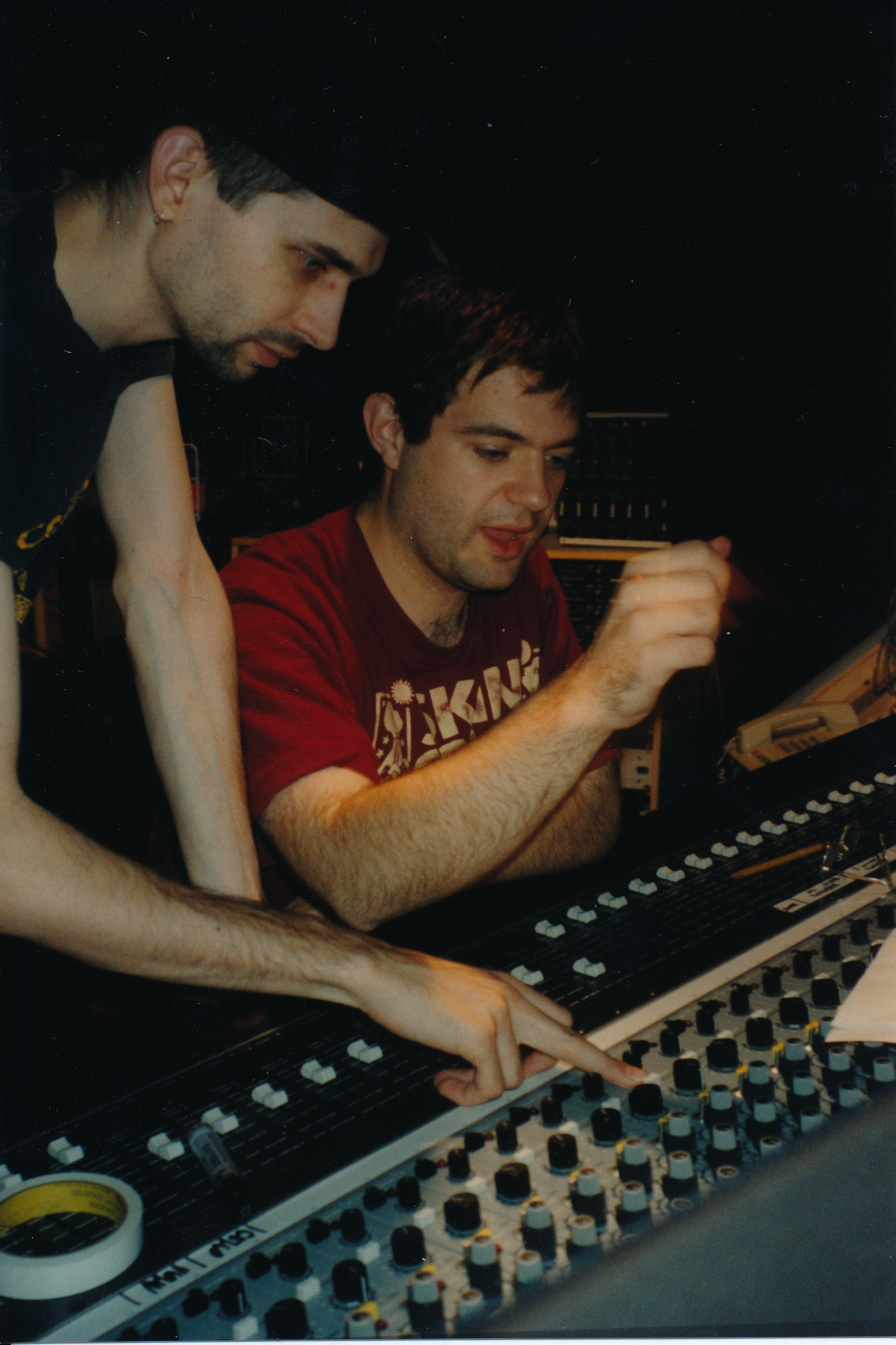
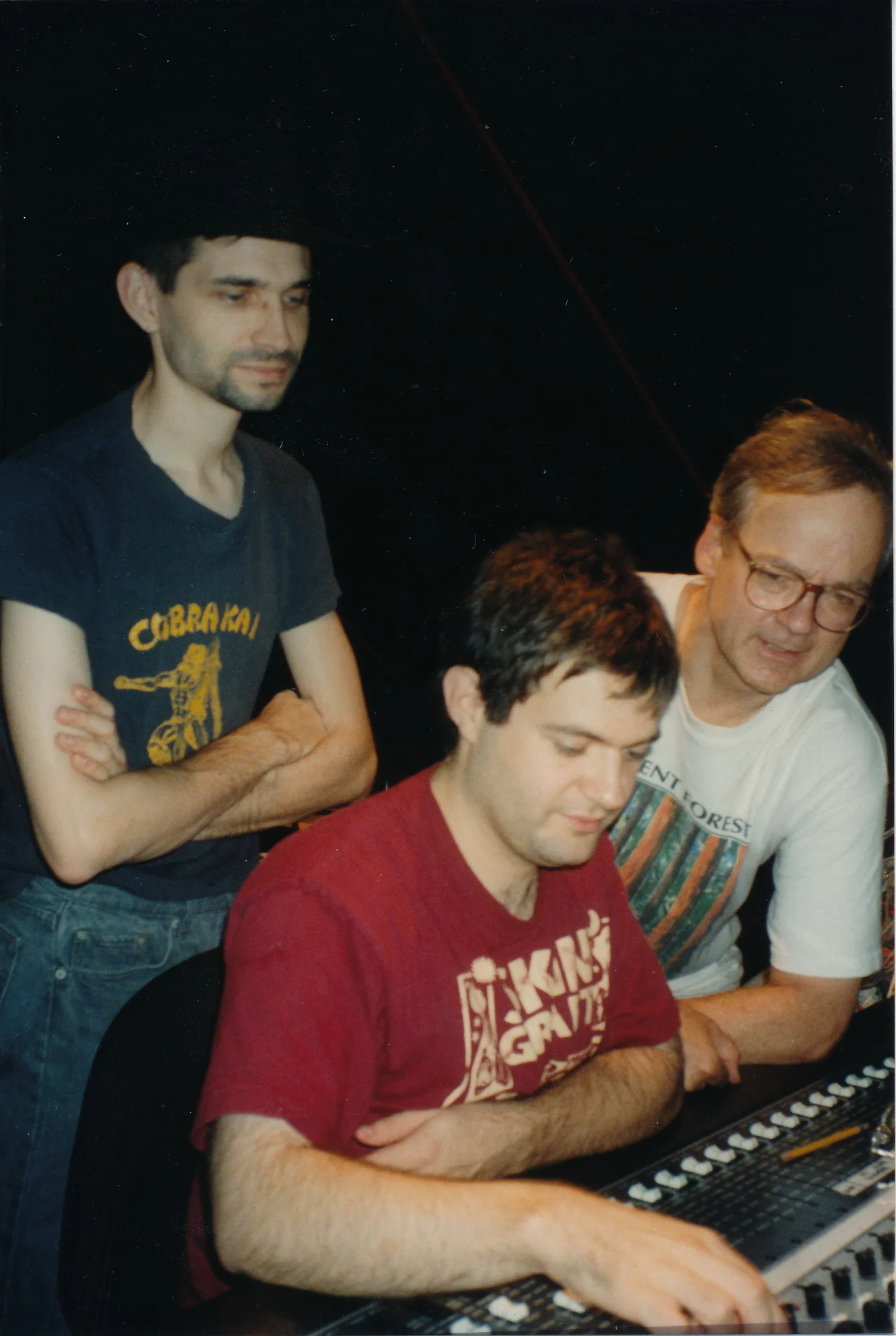
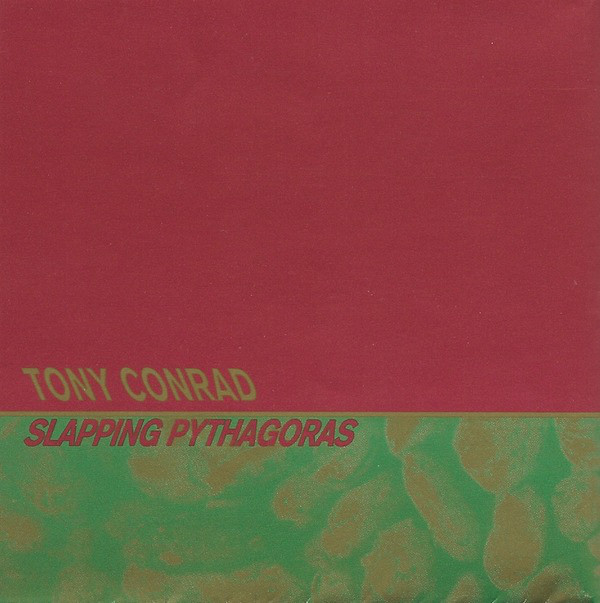
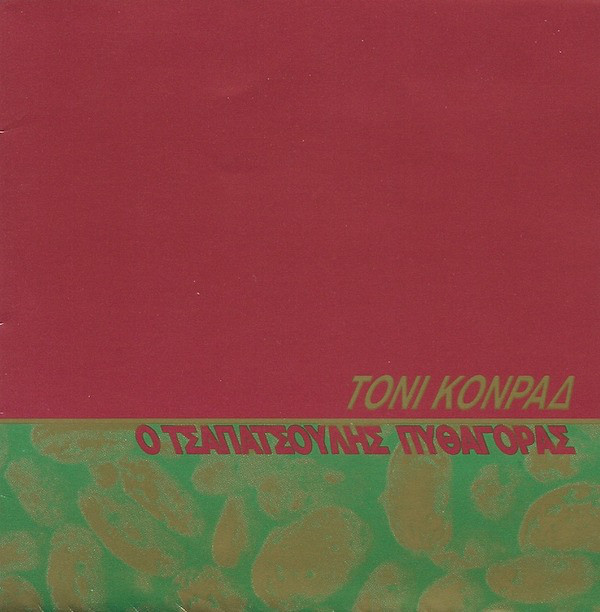
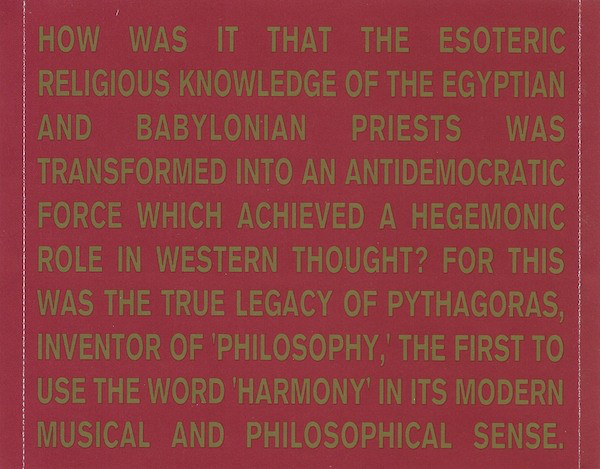
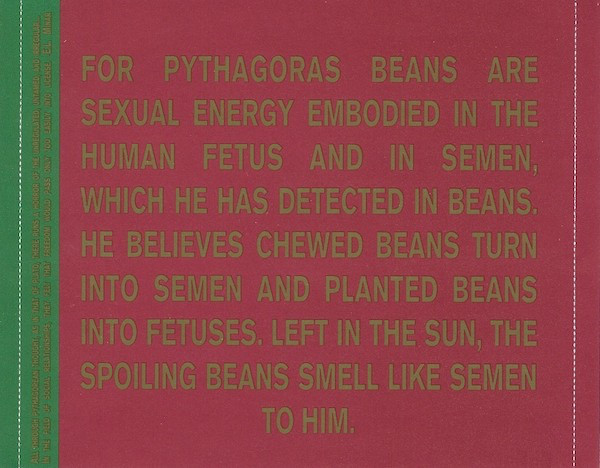
Tony Conrad
Slapping Pythagoras
1995
Table of the Elements
[Vanadium] TOE-CD-23
Compact disc, poster, obi
Tony Conrad is one of the most compelling figures in 20th century music, but it was this 1995 Table of the Elements release that defiantly established his relevance and influence for a new generation of listeners.
Conrad's previously obscure past is now well documented. In 1962 he co-founded the groundbreaking minimalist ensemble informally known as the Dream Syndicate. Wielding a drone both aggressively confrontational and subtly mesmerizing, he and his collaborators—including La Monte Young, Marian Zazeela, John Cale and Angus MacLise—created some of the most revolutionary music of that—or any—decade. A chasm continues to widen between Conrad/Cale and Young/Zazeela and their starkly differentiated philosophies, as Young refuses any and all access to their extensive and collective archive of recordings.
Following the dissolution of the group in 1966, Conrad played a pivotal role in the formation of the Velvet Underground, before refocusing his efforts on experimental film and video. However, he did briefly and momentously reappeared to jam with German group Faust on the notorious 1972 LP, Outside The Dream Syndicate (also available as a double-CD on Table of the Elements). For another two decades, this remained his only available studio recording.
In 1994, Table of the Elements devised a daring approach to return Conrad to the recording studio and afford him an opportunity direct a new ensemble gathered from Chicago’s burgeoning post-rock scene. Over the years, Conrad had repeatedly groused that Faust’s producer Uwe Nettlebeck had mixed him soft on Outside the Dream Syndicate, which in Conrad’s words, made him “sound like a hippie.” With some prescient determination, the label arranged for Conrad to record at Electrical Audio, with engineer Steve Albini.
Albini had just rattled the music industry by refusing to dilute his raw, bellicose mix for Nirvana’s In Utero: His was a studious and methodical close-mic’ed attack that eschewed commerce for aural iconoclasm. While it freaked out the suits in Los Angeles, this sensorial vérité was delightfully attuned to Tony Conrad’s personal aesthetic. The sessions, piloted with crackerjack brilliance by producer Jim O’Rourke, finally captured with harrowing accuracy the Scrape und Drang of Conrad’s relentless and epic performance idiom.
The ultimate result was 1995’s micro- and macroscopic landmark, Slapping Pythagoras. It is as exhilarating, vigorous and downright antisocial as any great rock album—which is exactly what it is. Slapping Pythagoras reconfigures the lost dream music, addresses nearly thirty years of silence, and confirms Conrad as a giant in the soundscape of American music.
“In the beginning there was the Drone, the primordial, mind-splitting hum generated by the strings, keyboards and revolutionary lost-chord Zeitgeist of 60's group the Dream Syndicate ... Slapping Pythagoras is the sound of stasis in excelsis, the fluid microtonal Om of Conrad's violin resolving into deep pools of rich, alien harmony."
Rolling Stone
"Tony Conrad is a pioneer, as seminal in his way to American music as Johnny Cash or Captain Beefheart or Ornette Coleman, one of those really savvy old guys whom all the kids want to emulate because their ideas, their style are electric and new and somehow indivisible."
Atlanta Journal-Constitution
“Conrad invents a new musical language ... unbearably intense and gloriously ecstatic."
The Wire
“Slapping you Pythagoras, it makes me feel I’m rising, like watching falling water.”
Jim O’Rourke
Tony Conrad
Richard Youngs
Faust
Keith Rowe
untitled [“Nickel”]
1995
Table of the Elements
[Nickel] TOE-SS-28
7” single, hand-etched vinyl, cloth sleeve, silkscreen, poster
In the summer of 1995, Table of the Elements toured the U.K. and U.S. with these five artists, in various combinations. This single was pressed in an edition of 250 and given away for free at the shows. The A-side has five tracks, edited end-to-end by Jim O'Rourke (some recorded by O'Rourke and/or Steve Albini); the B-side is etched by hand and has details about the tour. The sleeve is cloth and silkscreened. The track from Faust was their first release of new studio material since the 1970s.
“This free record is for everyone who supported our live events in London, Manchester, NYC, Hartford and Chicago during February and June, 1995."
Tony Conrad
Ten Years Alive on the Infinite Plain
with David Grubbs, Jim O'Rourke
Table of the Elements "Yttrium" Festival Chicago, IL
November 7, 1996
Director: Tyler Hubby
Projectors: Jeff Hunt, Dan Allen
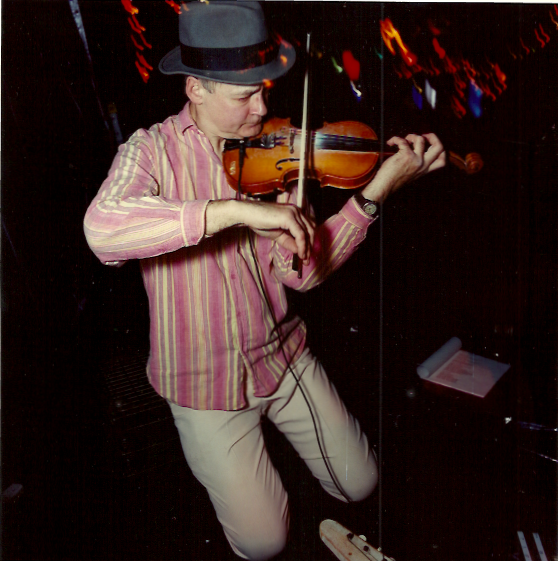
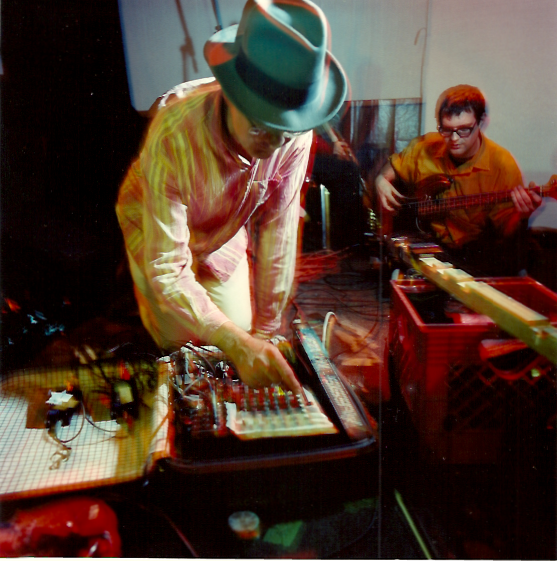

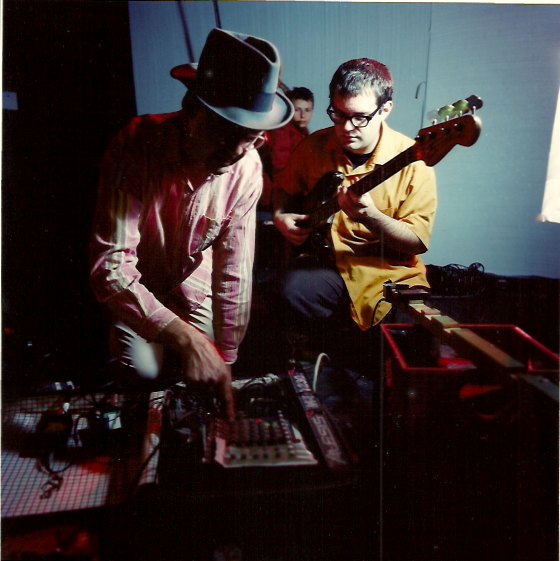

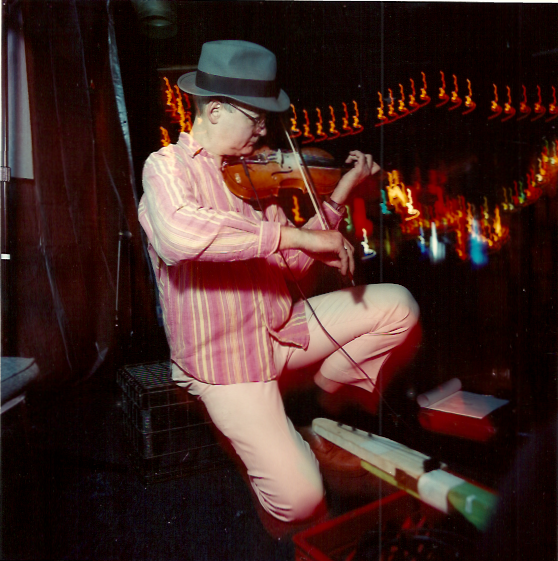

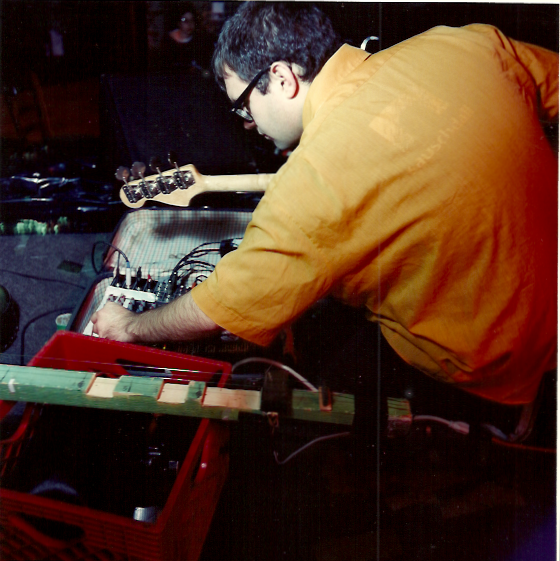
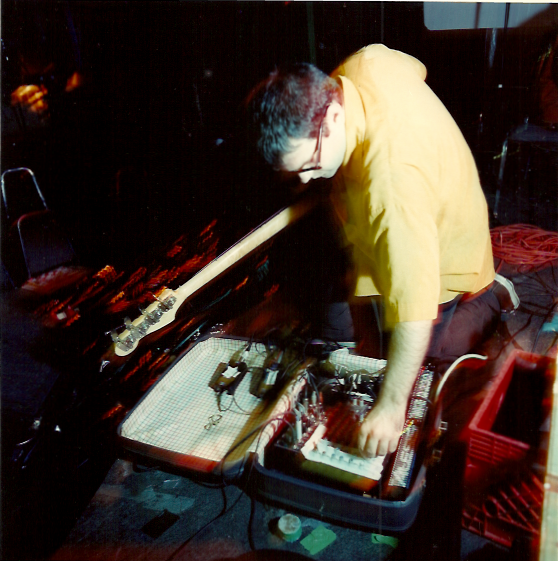
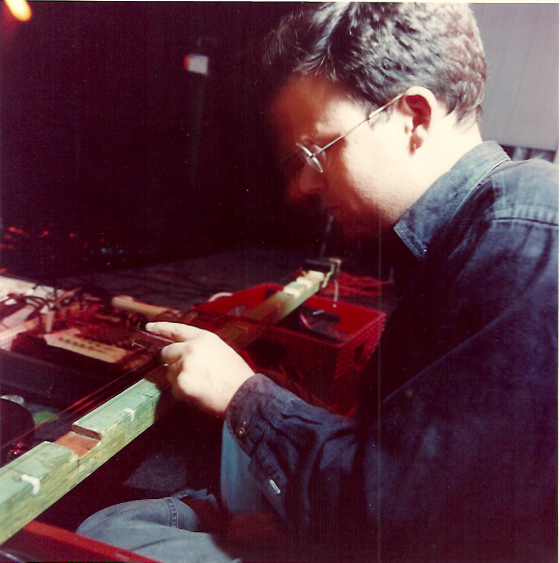
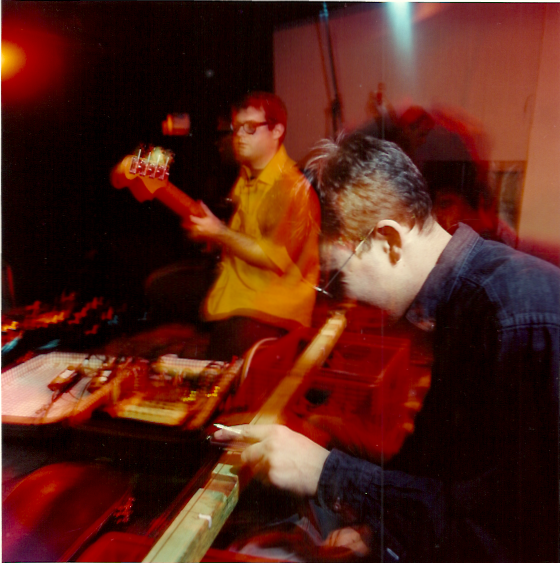
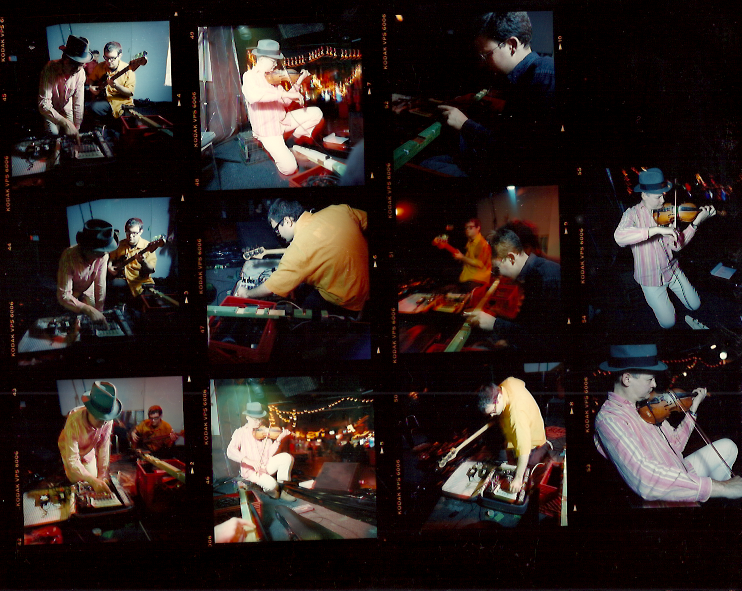
Tony Conrad Collection no. 06)
Tony Conrad/Gastr del Sol
Ten Years Alive on the Infinite Plain
Gastr del Sol
The Japanese Room at La Pagode
Tony Conrad
May
1995
Table of the Elements
[Copper] TOE-SS-29a
2x 7”singles, 21.75”x29” poster
Tony Conrad Collection no. 07)
Gastr del Sol
The Japanese Room at La Pagode
Tony Conrad
May
1995
Table of the Elements
[Copper] TOE-SS-29b
7”single, 21.75”x29” poster
“I went to the Japanese room at La Pagode to see an autobiographical film by a French director. It opened with footage of Cairo during the Gulf War. The director was represented by a milddle-aged Egyptian writer: same glasses. I was still weighing the merits of the Arabic voiceover when, unexpectedly, the film about Cairo ended and a film about the French Director began in earnest.”
“Why May Day? In honor of Maia, Roman ‘good goddess’ of fertility and women’s chastity, worshipped only by women. Love is not a suitable topic for music made by those whose history stinks of their habitual suppression of women. Why May Day? An international workers’ day in celebration of women and men together not as lovers but at labor. The high and low voices in polyphony signify women’s and men’s equity in a society unsoiled by the stain of love. Why ‘May Day!’ as men in distress face death? Love in music is only to yoke woman in opposition to man.“
“I had a dream that I shared a space with every living thing. Huge and waiting in the even light there stood a wall covered with windows and doors variously labeled with animal spoors and marked with names. As soon as I focused it clearly, each ancient door mysteriously became open, and a sound current flowed out all over the infinite plain. Other doors opened from time to time, reverberating the sound everywhere, but differently. And then suddenly there was nothing alive – but nothing had changed, and when I had returned, the sound was still there.”
Available in limited quantities, this split Gastr del Sol/Tony Conrad record was originally released in 1995. The Gastr side features one of their earliest efforts at intensive multi-track recording; instrumental passages segue through the faint murmur of a thousand voices. Conrad’s contribution is excerpted from an unreleased version of Early Minimalism: May 1965, recorded at Steve Albini’s studio with Jim O'Rourke and Bob Weston (Shellac). The packaging is, arguably, the most lavish of any Table of the Elements release: the sleeve unfurls into a 21” x 29" poster, displaying texts by the artists in metallic plum and copper inks.
The first 500 copies contained a second record, featuring an excerpt from an unreleased recording of Tony Conrad’s Ten Years Alive on the Infinite Plain (1971): Tony Conrad, violins; Jim O'Rourke, Long String Device; David Grubbs, bass. Recorded at Jim’s Steam Room studio, 1995.
“Completely mesmerising, the instinctively fearless results are belied by a conceptual and mathematical rigour that boldly asserted Conrad’s convictions in a unity and transcendence of all things. And yet whilst divorced from the visual aspect of the performance - a row of quadruple projections arranged side-by-side, incremental overlapping to form a pulsating picture - which was surely a major part of the piece, the sonic results still carry a potent meaning through its durational reinforcement of purely dissonant tunings and insistently dragging yet forward motion - an inexorable drive intently focussing themselves, and the listener, in the eternal traction of the present.
“In terms of that effect at least, we could compare the piece’s intensity and heightened hallucinogenic qualities with extended studies such as Éliane Radigue’s Transamorem - Transmortem, Alvin Lucier’s Music On A Long String Wire or Harley Gaber’s Wind Rises In The North, for example, yet there’s something utterly primal at play that bucks all those references, and appears closer to a prescient, overproof distillation of folk immediacy, rock’s lusting urge, and the hypnosis of tribal/trance/techno musics.
“It’s a completely stunning piece of music that will repay the attentive, attuned listener with endless rewards.”
Boomkat
“Gastr del Sol’s musical universe is filled with juxtapositions; for years Grubbs and O'Rourke have constantly futzed with the musical boundaries of the hybrid genre of “innovation,” one they seem to spontaneously reinvent. “
Artforum
"Tony Conrad is a pioneer, as seminal in his way to American music as Johnny Cash or Captain Beefheart or Ornette Coleman, one of those really savvy old guys whom all the kids want to emulate because their ideas, their style are electric and new and somehow indivisible."
“[John] Cale left the Dream Syndicate for the Velvet Underground; Conrad found a community in avant-garde film. But after Reed fired Cale from the VU and he was at loose ends, he and Conrad revived their string-drone collaborations. Some of these works can be found on the box set John Cale: New York in the 1960s, released in 2000 on Jeff Hunt’s Table of the Elements label. Hunt, who played a big part in Conrad’s return to music in the early 1990s, is one of the film’s most articulate expert witnesses to Conrad’s artistic achievements. … In 2000, Table of the Elements finally released digital remasters of three early-’60s Dream Syndicate recordings, which Hunt says appeared mysteriously in the mail one day, as well as the boxed set Tony Conrad: Early Minimalism, which includes one work that is actually “early,” Conrad’s divine Four Violins (1964), as well as other disks by Conrad, MacLise, and Jack Smith.”
Amy Taubin, Artforum
Tony Conrad Collection no. 08)
Tony Conrad
Four Violins (1964)
1996
Table of the Elements
[Chlorine] TOE-LP-17
Phono LP, 180 g. vinyl, gatefold jacket, poster
In 1962 Tony Conrad's amplifed strings introduced the sustained drone of just-intonation into "minimal" music. Conrad, together with John Cale, Angus MacLise, La Monte Young, and Marian Zazeela formed a performance collaboration from 1962-65 sometimes known as the Dream Syndicate. Utilizing long durations and precise pitch, their aggressively mesmerizing "Dream Music" denied the activity of composition, articulated their shared ideas of performance, and established the Big Bang of "minimalism."
When this remarkable group dissolved in 1966, their many rehearsal and performance recordings were repressed by Young and Zazeela, and became the stuff of legend. Conrad himself stepped outside of the Dream Syndicate once: on December 19, 1964 he recorded Four Violins, his only 1960s solo tape of violin playing.
Beautifully packaged in a gatefold jacket with metallic inks, pressed on superior-grade, 180 g. vinyl.
"The most striking quality of Four Violins is its instant familiarity: the grating sound of the violin parts imparts a vision of a uniquely American distance, the feel of a continent. It's a quality also present in the spaces surrounding John Fahey's or Loren Mazzacane's rattled notes, the early Sun recordings, the compositions of Charles Ives, the righteous soul-breath of Albert Ayler. With Four Violins Conrad moves closer to sound-essence, to ringing out the notes which have always existed in the skies of America.
"The joy comes from connecting with Conrad's language, from following its own logic—like railroads roaring out into the Midwest. This is a landmark recording in every sense, and the fact that this is only the first of many forthcoming Conrad installments from Table of the Elements makes me feel like howling with joy."
David Keenan, The Wire
"Tony Conrad is a pioneer, as seminal in his way to American music as Johnny Cash or Captain Beefheart or Ornette Coleman, one of those really savvy old guys whom all the kids want to emulate because their ideas, their style are electric and new and somehow indivisible."
Steve Dollar, Atlanta Journal-Constitution
"Minimalism's critical document... Astonishing"
Art Papers
"100 Records That Set the World on Fire"
The Wire
"Totally uncompromising ... a marvel."
Artforum
"The perfect sound."
Chicago Reader
"Brain-blistering."
Luna Kafe
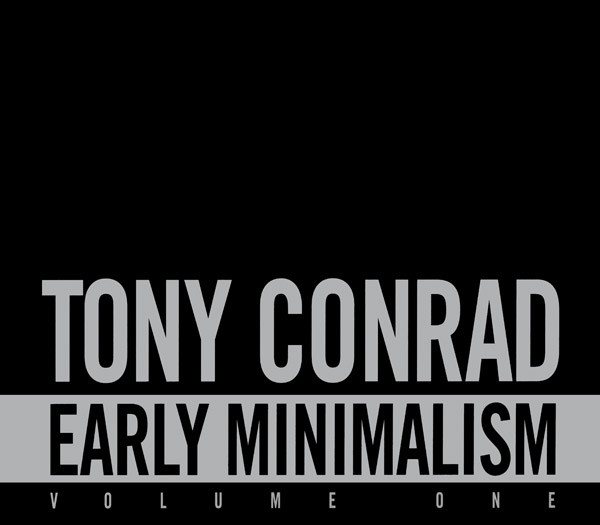
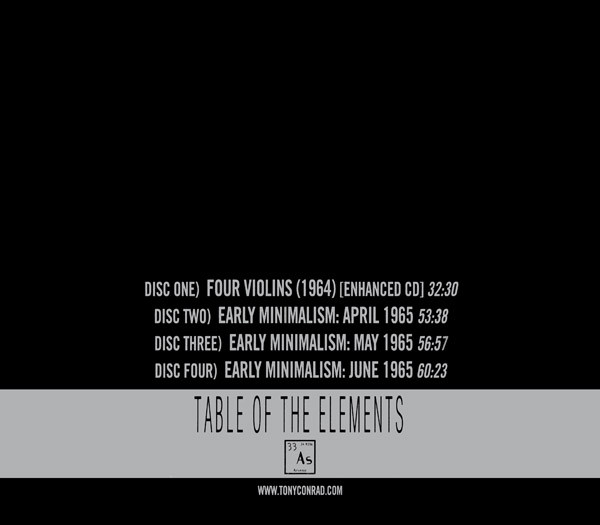
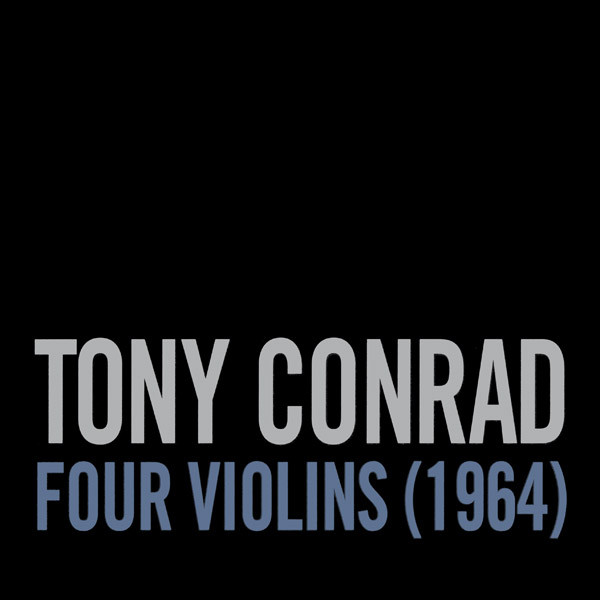


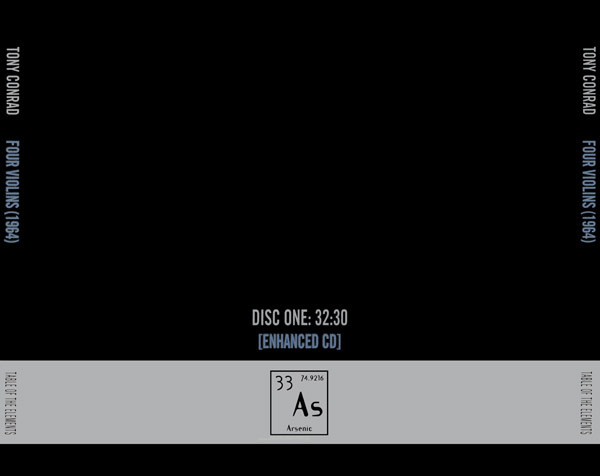
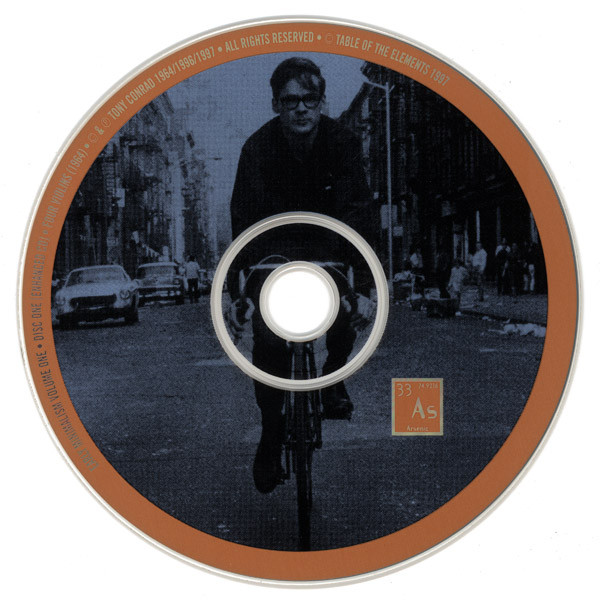
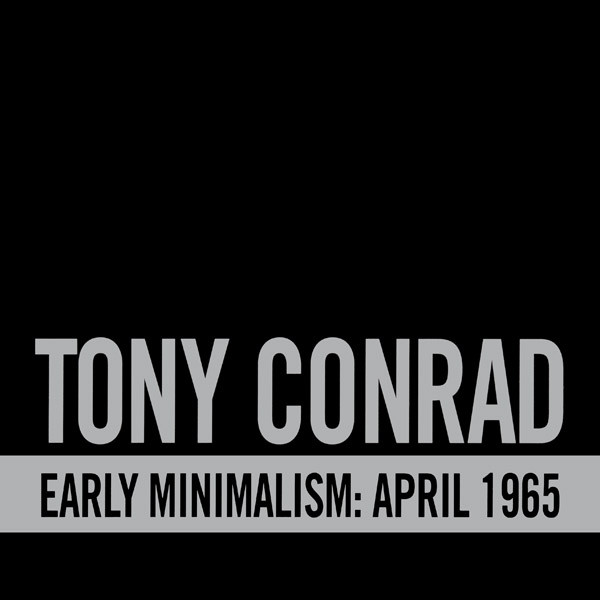
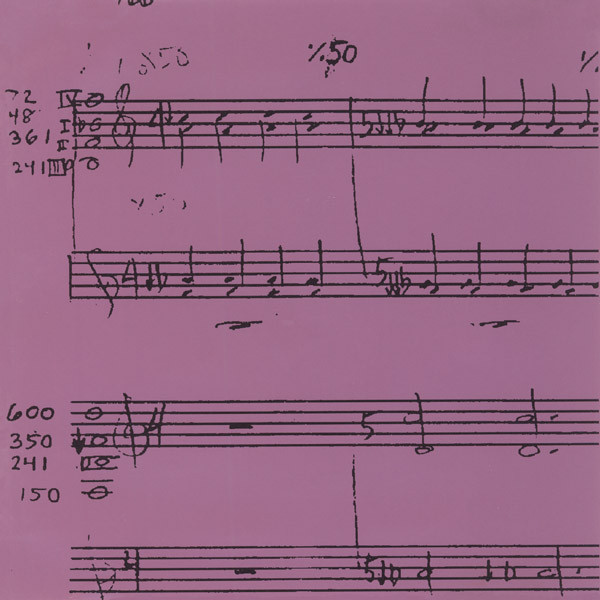
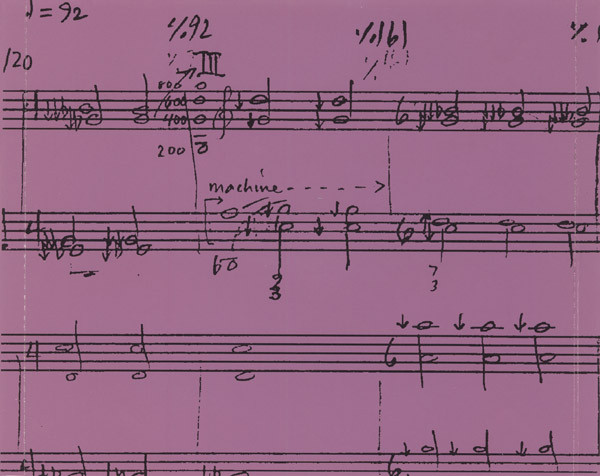
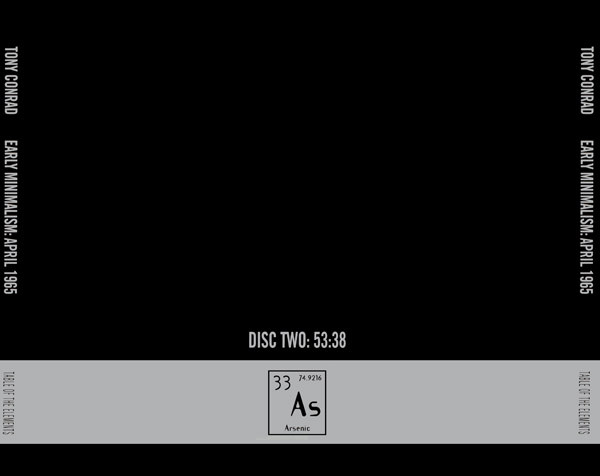
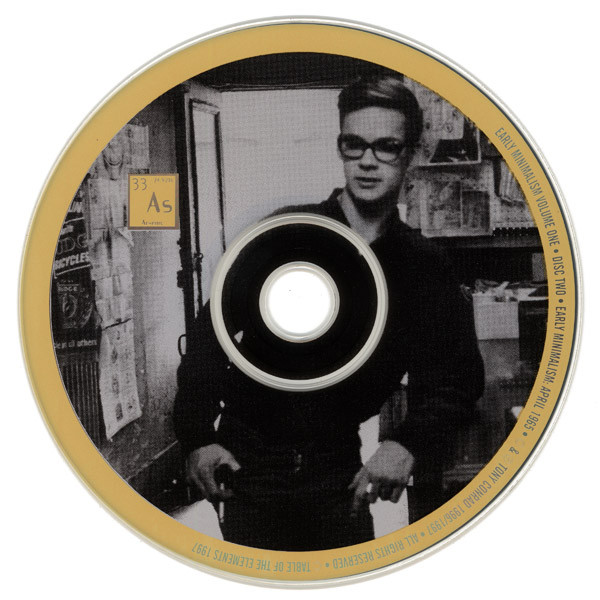

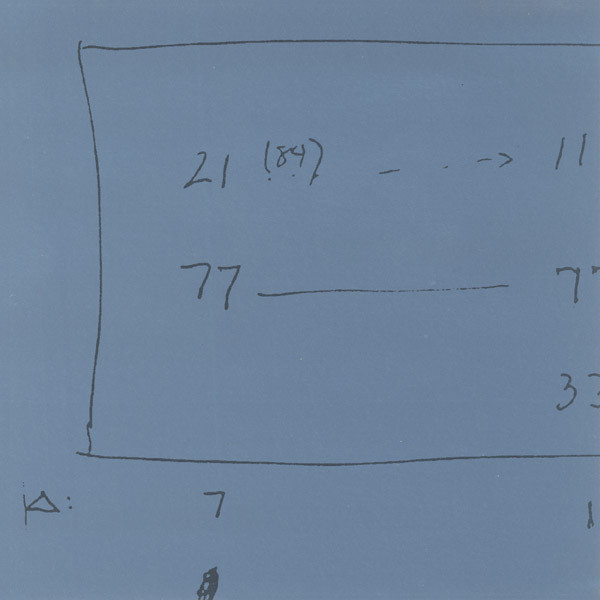

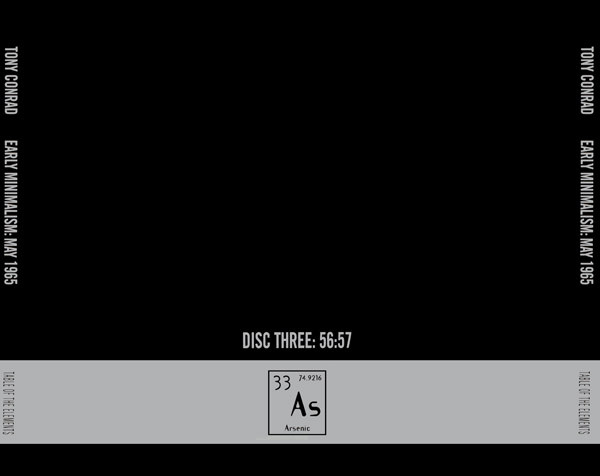
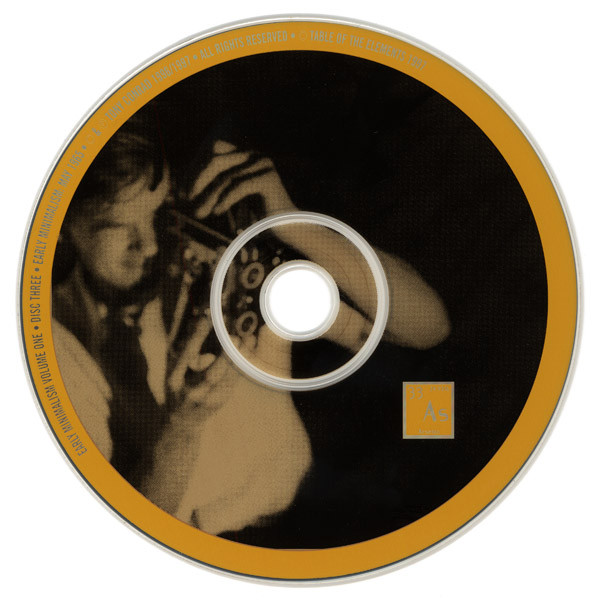
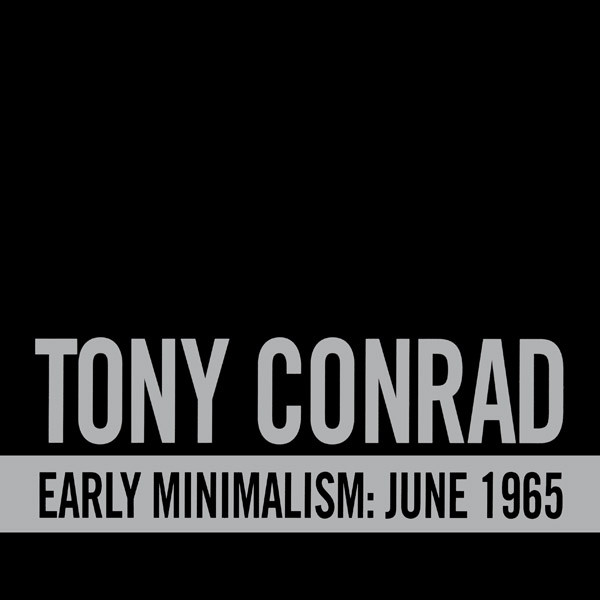
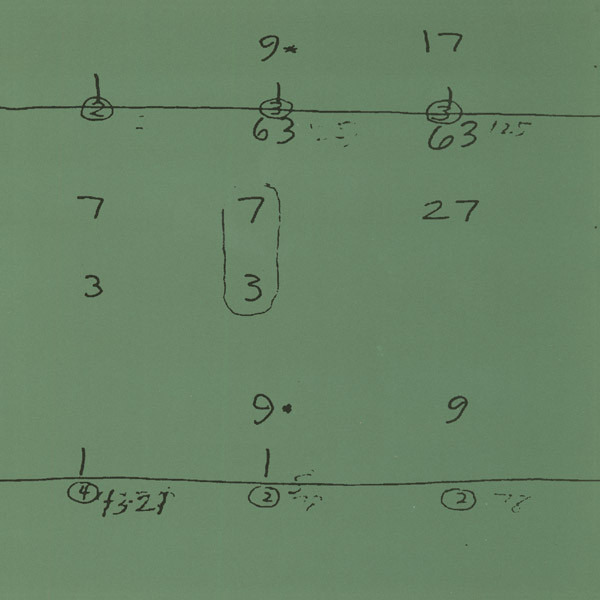
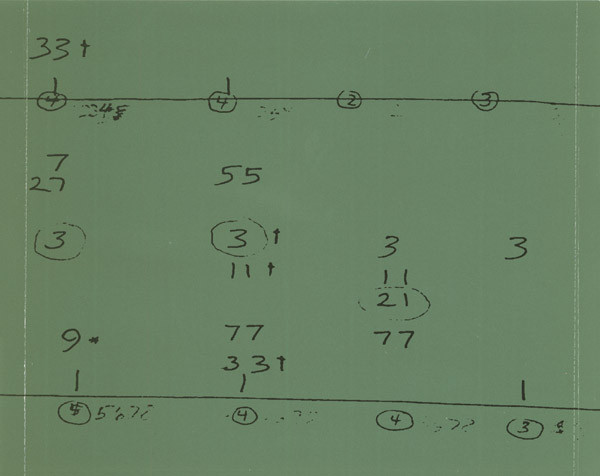
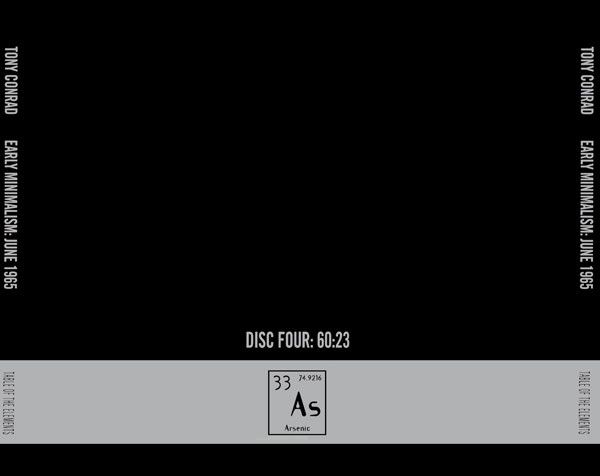


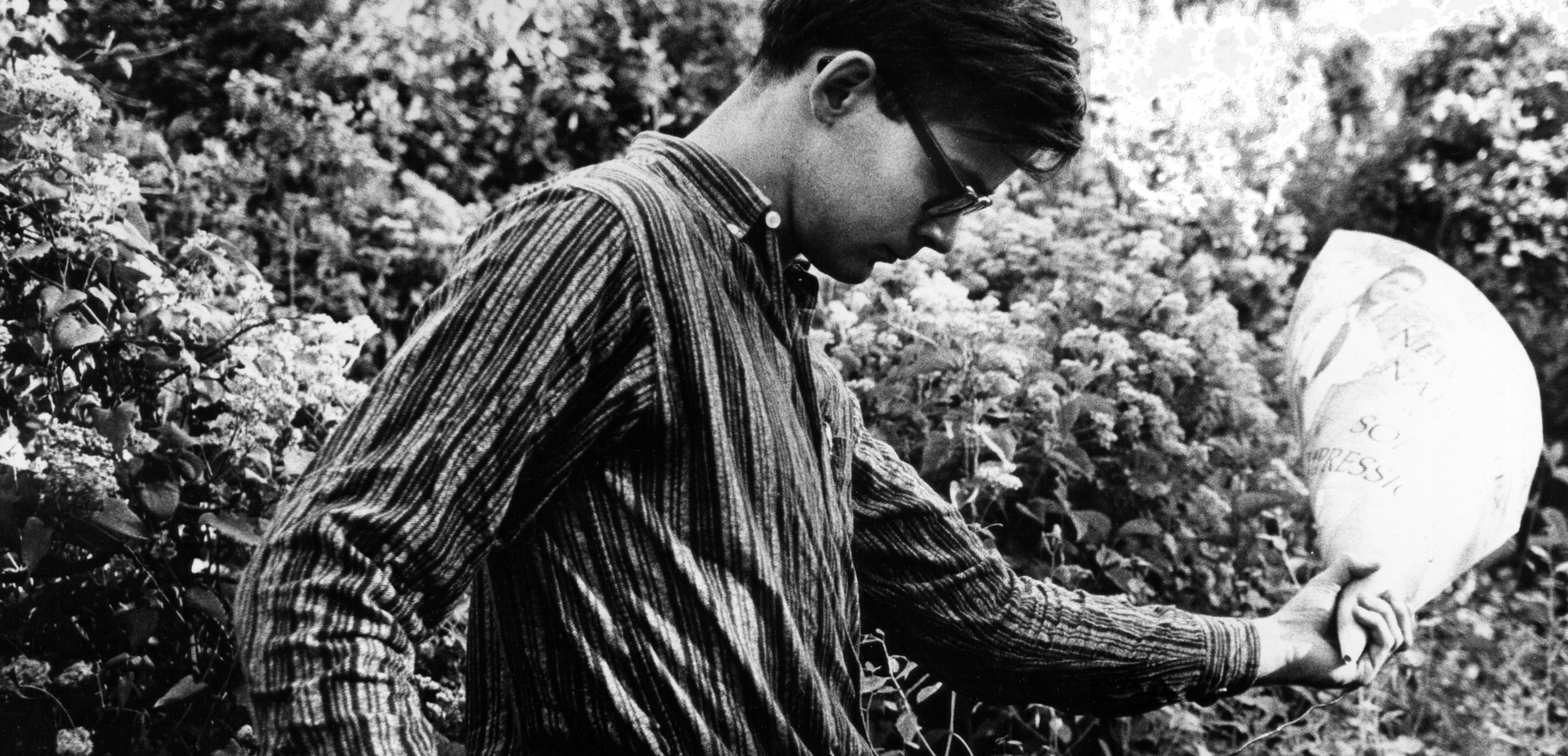
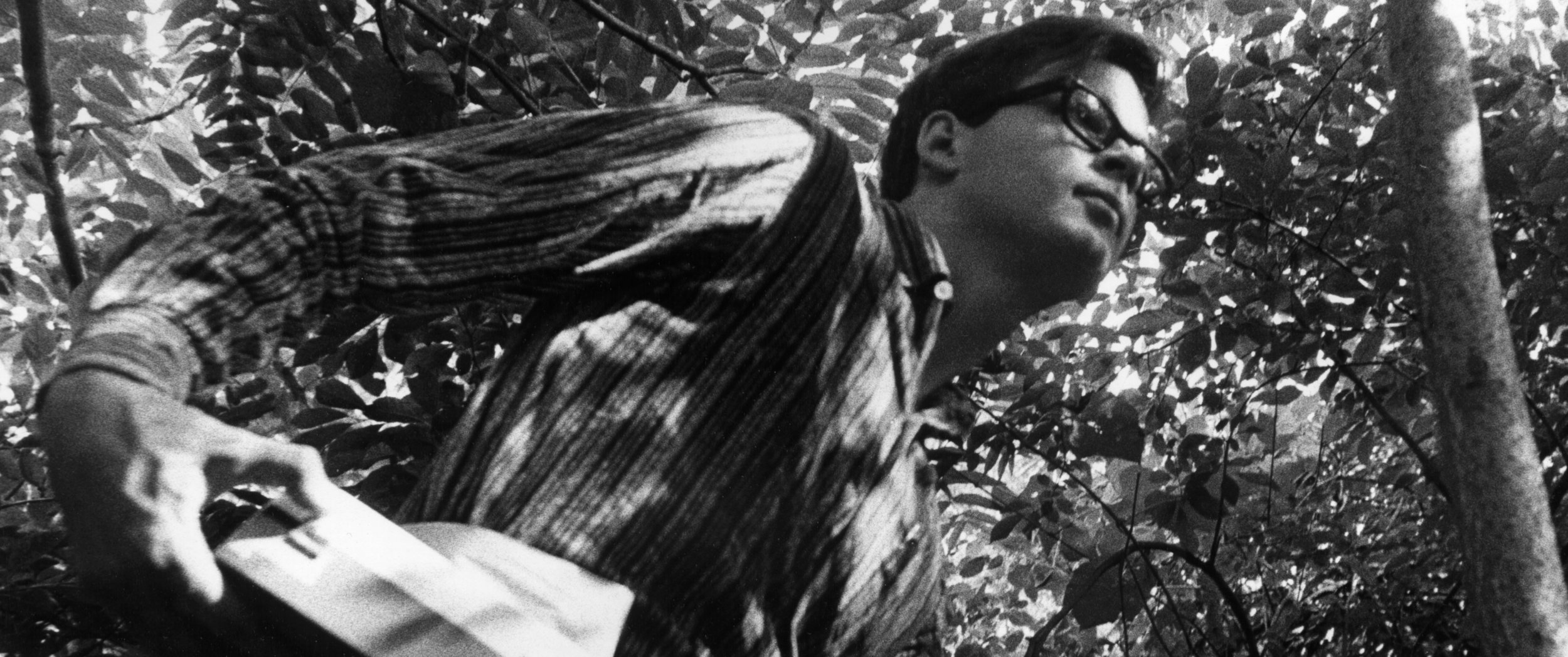
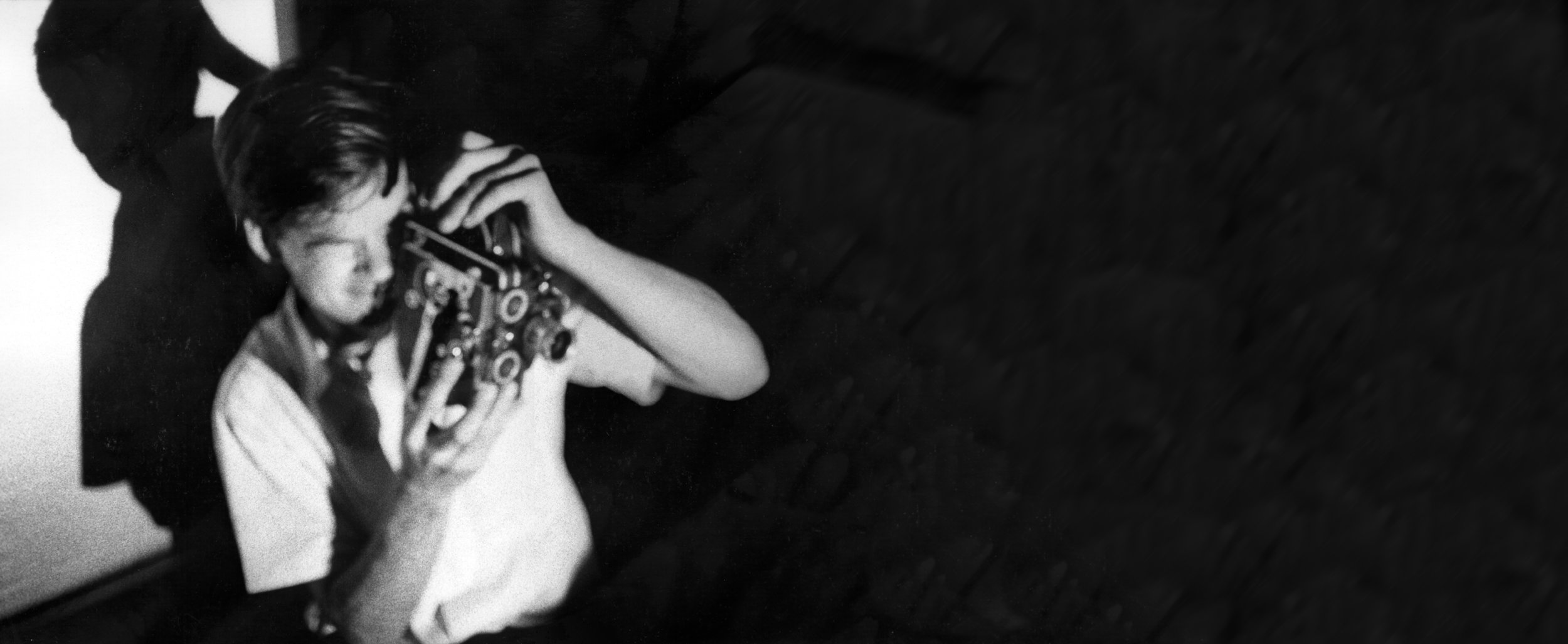


Tony Conrad Collection no. 09)
Tony Conrad
Early Minimalism Vol. I
1996/2002
Table of the Elements
[Arsenic] TOE-CD-33
4x compact disc box, 112-page book, video, custom enclosure + catalog
"History is like music—completely in the present.”
In 1962 Tony Conrad's amplified strings introduced the sustained drone of just-intonation into what came to be known as "minimal" music. Utilizing long durations and precise pitch, he and his collaborators forged an aggressively mesmerizing "Dream Music"—denying the activity of composition, elaborating shared ideas of performance, and articulating the Big Bang of "minimalism." However, the many rehearsal and performance recordings from this period were repressed, inaccessibly buried.
In 1987 Tony Conrad set out on a ten-year return expedition to the site of these entombed fragments to unearth the losses; from them he reconstituted and regenerated the epic Early Minimalism. Reaching back through time, Tony Conrad weaves a mobile narrative over and under minimalism: making music out of history, and history out of music.
“Tony Conrad is a pioneer, as seminal in his way to American music as Johnny Cash or Captain Beefheart or Ornette Coleman, one of those really savvy old guys whom all the kids want to emulate because their ideas, their style are electric and new and somehow indivisible."
Atlanta Journal-Constitution
“Early Minimalism, steeped in its history, is a victory for the highly influential Tony Conrad. What's more, the box set, along with its 90+ page-liner notes and CD-ROM, gives an excellent psychological look at a man who has refused to give in to injustice. Glorious."
Flagpole
“Tony Conrad invents a new musical language ... unbearably intense and gloriously ecstatic. A landmark recording in every sense."
The Wire
“Totally uncompromising ... a marvel."
Artforum
“The perfect sound."
Chicago Reader
“Groundbreaking."
Billboard
“Brilliant."
New York Times
"'Outrageous?' You should have heard the Dream Syndicate."
—Lou Reed, in response to critical attacks on his Metal Machine Music LP, 1975
John Cale
Tony Conrad
Angus MacLise
La Monte Young
Marian Zazeela
Day of Niagara (1964)
Inside the Dream Syndicate Vol. I
2000
Table of the Elements
[Tungsten] TOE-CD-74
Compact disc
"In the beginning there was the Drone, the primordial, mind-splitting Om generated by the strings and revolutionary lost-chord Zeitgeist of 1960's group the Dream Syndicate."
Rolling Stone
"'Outrageous?' You should have heard the Dream Syndicate."
Lou Reed, in response to critical attacks on his Metal Machine Music LP, 1975
From 1962 through 1965 John Cale, Tony Conrad, Angus MacLise, La Monte Young and Marian Zazeela participated in a collaborative ensemble that articulated the Big Bang of "minimalism." Utilizing long duration and precise pitch, they forged an aggressively mesmerizing "Dream Music"—denying the activity of composition and elaborating shared ideas of performance and improvisation. However, the many rehearsal and performance recordings from this period were repressed, and remained inaccessibly buried until this moment. Now, with the recent discovery of an additional cache of tapes, digitally restored and remastered, the world can step inside the Dream Syndicate for the very first time.
"This is a 31-minute drone. It's also probably the most important historical release of the year. After a decades-long wait, we're finally able to hear the original Dream Syndicate, the legendary ensemble of '62-'65, which influenced thousands solely through its reputation. It's the bite of Tony Conrad's razor-sharp violin, together with the blistering howl of John Cale's prepared viola, which makes this music so much more than so much of what's come after it. Conrad and Cale are the motor, producing a sound like the world itself exploding, only in slow motion and with absolute precision. An instant classic, still jaw-dropping after a 35-year hibernation."
Other Music
"Lou Reed's infamous Metal Machine Music; Jim O'Rourke's unlikely entrance in the pantheon of indie rock; and Sonic Youth's worship of the avant-garde; these instances and countless others were all born from the same seed: the legend of the Dream Syndicate. One of the most significant and controversial releases of 2000, Inside the Dream Syndicate is the high-throttle point when 20th Century Classical almost became rock 'n' roll. This is the Big Bang of Minimalism."
Pitchfork
"These recordings are (part of) a library of effort that represented, for Tony and I at least, a labour of love. The power and majesty that was in that music is still on these tapes."
John Cale
"The great missing link between classical and popular music—and Eastern and Western music—of the late 20th century. A monumental achievement."
Creative Loafing, Atlanta
"No lie, this might be the most historically significant music release of the last 20 years . . . A fantastic piece of deeply ecstatic sound."
Aural Innovations
"A heavenly din of hellish proportions. Definitely a coup for one of the most interesting labels in America, Table of the Elements."
Earpeace
“One of the most important recordings to emerge from the mid-1960's, a product of extraordinary sonic force.”
Boomkat
"A bracing and powerful document of a hugely influential ensemble that changed the sound of modern music."
Chicago Tribune
"Number 1 'Not-Pop' Release of 2000"
LA Weekly
"This music will drill you a third eye."
The Bob
"Downright loud and vicious."
Blastitude
"Exhilarating."
New York Times
"A bombshell."
Art Papers
"Amazing."
Village Voice
"Mindbending."
Spin
"The skyscraping wall of amplified string drone that is erected here towers over almost everything. Coupled with Cale's hypnotic, deafening, avant-rock viola is Conrad's equally impressive double-stop violin playing. Together they produce the sound illusion of some huge electrical generator, a grinding musical turbine that is forever shooting sparks to ignite the imagination... Day of Niagara is an incredible piece of music. That it exists and is, at last, available to anyone who wants to hear it is nothing short of a miracle. Rejoice!"
The Wire
“Ladies and gentlemen, forget about floating in space. We are floating in dreams-- dreams woven of sustained overtones, duration and pitch playing tricks on our ears and distorting our sense of time and place. It began with this, funny enough. Lou Reed's infamous Metal Machine Music; Jim O'Rourke's unlikely entrance in the pantheon of indie rock; all those SYR EPs and Sonic Youth's rectum-suffocated worship of the avant-garde; these instances and countless others were all born from the same seed: the legend of the Theatre of Eternal Music, La Monte Young's Dream Syndicate.
“One of the most significant and controversial releases of 2000, Inside the Dream Syndicate offers a glimpse behind the mysterious curtain. It's what you might have heard had you been fortunate and bold enough to sit in on one of the Dream Syndicate's legendary '60s performances. Mind-numbing waves of amplified strings, slowly bowed to maintain overlapping drones the likes of which you never thought you'd ever want to listen to-- alienating, enveloping sound, seemingly devoid of notation and sense.
"’Outrageous!’ was the cry when Lou Reed unleashed Metal Machine Music. ‘You should have heard the Dream Syndicate,’ was Reed's response. But don't let the band's name fool you: they're not to be confused with the Paisley Underground psych-pop band that adopted the moniker as a high-brow homage in the early '80s. This is the high-throttle point when 20th Century Classical almost became rock 'n' roll. This is the Big Bang of Minimalism. And just look at the star power: a pre-Velvets John Cale on viola; venerable avant-garde composer and filmmaker Tony Conrad on violin (he was Mercury Rev's mentor at SUNY Buffalo, don'tcha know); poet and percussionist Angus MacLise on tabla; and one of the weirdest, most visionary of artistic marriages in John Cage protégé La Monte Young and visual artist Marian Zazeela, who provide vocal drones and conceptual direction to the project.
“La Monte Young owns the original performance and rehearsal recordings of the Dream Syndicate and refuses their release, much to the frustration of Cale and Conrad. He insists that he should be credited to the sole "composer" of the music-- himself. Cale and Conrad have always maintained otherwise, that it was a collaborative effort in performance and improvisation, and that they shall never cede complete authorial credit to Young alone. This dispute, along with Young's intractable perfectionism, has prevented the world for the past 35 years from hearing just what those five headcases were up to.
“However, some high-quality bootlegs ("an additional cache of tapes," it's said) have surfaced, so here we have it: a healthy dose of controversy and confusion, and the first semi-legit release of Dream Music ever, credited to all five. La Monte Young is pissed, noting imperfections in the mix, length, etc. But any way you cut it, avant-garde indie Table of the Elements has balls, and this release is ideal.
“This music is not meant to be listened to on headphones. It is difficult, should fill space, bounce off walls, clear rooms, and mess with your head. Appropriate volume levels do not exist for what is on this disc. Originally, Dream Syndicate performances were debauched night-long endurance tests, presaging the vibrant rave scene that would follow. Goodbye 20th Century? I think not. The past always comes back to haunt you.”
Pitchfork Media
April 30, 2000
The Theater of Eternal Music performing in 1965. From left, Tony Conrad, La Monte Young, Marian Zazeela and John Cale.
Tony Conrad Collection nos. 11) 12)
Tony Conrad
Fantastic Glissando (1969)
2003/2005
Table of the Elements
[Lead] TOE-LP/CD-82
Phono LP/compact disc, enclosure
It’s 1969, and Tony Conrad wants to take you Higher.
Celebrated for the thrilling roar of his amplified violin, Conrad is a founding father of ‘minimalism’ and a giant in the American soundscape. Now Conrad’s own Audio ArtKive imprint presents the first in a series of releases that reveal the wild breadth of his 40-year career, including field recordings, piano compositions, film soundtracks and more.
Fantastic Glissando (1969) is a series of [d]evolving electronic compositions created with sine-wave oscillators. The instrumentation is different, but the effect is typical Conrad: soaring, aggressively textured and jet-engine massive. This first-time CD release contains “Process Four of Fantastic Glissando,” a fifth track not included on the original LP version due to space limitations.
“Massive slab of temporal disruption from one of the most consistently wowing figures to come out of the cultural meltdown of the 1960s. Conrad was a key mover in the Lower East Side rock and avant underground in the early to mid 60s, playing with Lou Reed, John Cale and Walter DeMaria in Reed’s frat-rock combo, The Primitives, and standing in with early line-ups of The Velvet Underground. But it was his activities as part of The Dream Syndicate/Theatre Of Eternal Music, a group dedicated to extending waves of single note bliss into whole new zones of psychoactive ecstasy, that were to have the most far-reaching cultural impact. Alongside John Cale, Angus MacLise, La Monte Young and Marian Zazeela, Conrad founded a whole new approach to sound, working tiny pulsing intervals into long monotonal drones generated by bowed strings and vocals and birthing a minimalism several cells more blasted than the saccharine soundtracks associated with bigger hitting names like Philip Glass and Michael Nyman. Fantastic Glissando dates from 1969 and features four tracks of degraded sine-wave oscillations that approximate the roar of a fleet of V-2 bombers.”
Volcanic Tongue
“The media and reality: It's hard to attend both."
Tony Conrad Collection no. 13)
Tony Conrad
Bryant Park Moratorium Rally (1969)
2003/2005
Tony Conrad's Audio ArtKive/
Table of the Elements
[Bismuth] TOE-MP-83/TOE-CD-83
Free mp3/compact disc, matte varnish, matte enclosure, watermarked typing paper
An October afternoon in 1969. Midtown Manhattan. A rally in Bryant Park against the Vietnam War. Down 42nd Street towards Times Square, Tony Conrad is adjusting microphones in his 5th floor loft, one directed at the TV set—where it will pick up live local news coverage—the other pointing out the window, where the echo of speeches and crowd noise mingles with the oceanic rush of crosstown traffic. As the event is about to begin, he rolls tape. Thirty-four years later, we hear what he heard. And the juncture, for so many reasons, could not be more critical. As the Bush Administration pursues a risky military agenda in the Middle East—one with unsettling long-term implications both at home and abroad—we see a nation not divided, as in the Vietnam Era, but strangely complacent. Our media-saturated reality functions like a drug, instantly televised warfare a new entertainment, and organized public dissent a novelty at home and a roaring chorus everywhere else. Conrad's recording of the Oct. 15 Vietnam Moratorium Rally is an eerie flashback that offers urgent new insights into our own lives and times, post-9/11 and full on into a new millennium.
"This was one event that I didn't have to leave the house to attend," says Conrad, whose recording coincidentally chronicles not only the rally—an archival moment—but doubles as a kind of sonic residue of a New York City that doesn't quite exist anymore, a place as swept away by the tilt of time and the circumstance of history as the twin towers. The Times Square area, now a Disneyfied circus of commerce suitable for morning show wallpaper, once was something far scarier and more radically chaotic. And it was from this perch that Conrad spent the afternoon. He remembers: "The street was awash with humanity, but no one lived there. It was like being in a desert in some ways. The number of voters were very small. There were people of every stripe and pandering to every kind of base and debased desire. There was a huge crossover, because millions of people came to work there every day, but it was also skin deep. People lived at the edge of the gutter."
The perfect place to make your life as an artist, amid the democratic bustle. That ruckus is key to this recording, which indulges the composer's interest in issues of documentation, the nature of public spectacles, and the deep biological impulses that govern the individual's response in the face of a mass. "What quickens your pulse in the wake of thousands and thousands of people?" he asks, while holding up this construct to a dual one. "That phenomenon of somehow the abstract voice of the media that comes down to us, can shape individual reality."
With that in mind, listen to how the two channels of this tape define the gap between media (the instantaneous leap of audio from a microphone in the park, transformed into a signal, and broadcast through his television's speaker) and reality (the delayed and muffled arrival of the same information at his window). It was funny, Conrad notes: "Because being there is later than TV. This brings up the phenomenological notion of the present, whether we live in it or after it. So you have this situation of TV vs. live, or TV vs. the street, all these issues of presence. The tape invokes that time really accurately and thoroughly. It's a big chunk, and that makes things so much more different than a sound byte."
The rally, part of that date's full slate of public demonstrations against the war, proves to be at once poignant and a bit comical. Powerful oratory from the Rev. William Sloan Coffin (who cites the gospel according to Pogo: "We have met the enemy, and he is us.") shares time with quips from Rod McEuen. A stageful of Broadway stars enjoy cameos ("Dick Benjamin!"), while Dick Cavett and Woody Allen chime in with quick comments. Leading anti-war politicos—such as Eugene McCarthy and Shirley Chisholm—take the microphone. It's a remarkable day in the life of a city.
"People really owe it to themselves to go to these things," Conrad says. "Because these occasions are such important markers of the events of our time. The moratorium rally put the media and the people side-by-side, and presents a very important idea that comes into the picture in today's protests as well. The media and reality: It's hard to attend both."
Steve Dollar
New York City
August, 2003
Tony Conrad Collection no.14)
Jonathan Kane’s February
Arnold DreyblaTt
Rhys Chatham
Zeena Parkins
Tony Conrad
Tony Conrad with Faust
Leif Inge
A Field Guide to Table of the Elements, Southeast Edition
2005
Table of the Elements
[Thorium] TOE-CD-90
2x compact discs, custom enclosure, booklet, 18 x 12” poster
Everybody loves a mystery. Generations of record collectors have spent valuable chunks of their lives poking through vinyl bins in search of unknown pleasures, or rambling through the piney woods with their ears cocked for a high, lonesome sound. Think of Harry Smith, magical curator of forgotten 78 rpm discs, whose “Anthology of American Folk Music” created a rich mythology out of grooves dusty with neglect. Even revolutionary sounds can come and go with the scarcest trace. That’s part of the power they hold over the ardent, would-be listener. The truth is out there.
Since 1993, Table of the Elements has spoken that truth. The label has staked its claim on a massive enterprise: It intends nothing less than to rewrite the history of American music in the second half of the 20th century. And beyond. That’s a tall order for even the largest multi-national corporations, whose vaults harbor so much of our cultural data. Imagine, then, the flinty ambition necessary for Table of the Elements to pursue its goal. This modestly funded, cellular organization has thrived on smarts, and pluck, in realizing its projects, which have focused on musicians whose light shimmers outside the frames of convention. The label’s 100-plus releases are a vital contemporary archive, a survey of meaningful eruptions across a broad horizon of improvised, experimental, minimal and outsider musics.
During the past 13 years, the pop world has seen grunge give way to crunk and CDs yield to MP3s. Technology has mediated an ever-more globalized marketplace in which music has been made at once ephemeral and privatized, freely traded yet increasingly consumed in isolation. Table of the Elements looked at the longer haul, registering the ripples of music that are too essential to die or dissolve into the common currency. The label went prospecting for the rarest sort of sonic lode, the uncut goods blessed with a hearty half-life. The New York Times praised these actions for single-handedly “rescuing the underworld of 1970s and ’80s music from cassette-recorded oblivion.”
The label’s signature artist, Tony Conrad — a violinist whose primal enveloping drones create an oscillating ritual theater — has been prodigiously documented in a series of releases. These range from sumptuous packagings of lost classics (Conrad’s 1973 collaboration with Faust, “Outside the Dream Syndicate”) to new projects alongside young artists that the composer has inspired (“Slapping Pythagoras”) to recoveries of lost concepts given new breath (the epic 4-CD box set “Early Minimalism”). Conrad is joined on the label by other profoundly influential composers whose radical styles defy textbook definitions and challenge accepted notions of the minimalist canon: Rhys Chatham, Arnold Dreyblatt, Pauline Oliveros, Eliane Radigue, Laurie Spiegel and Velvet Underground co-founder (and Rock & Roll Hall of Fame inductee) John Cale. Cale’s remarkable early recordings made prior to his rock career were compiled in the 3-CD set “New York in the 1960s.” Founder Jeff Hunt’s efforts achieved a critical mass in 2000, with the controversial release of legendary “lost” collaborations from 1964 between Cale, Conrad, and La Monte Young. “Day of Niagara: Inside the Dream Syndicate Vol. I” topped numerous year-end “Best Of” lists and was lauded as “the most historically significant music release of the last 20 years.”
The label, however, has not been limited to that singular agenda. As minimalism’s creation myth has been challenged and outlined anew, there were other demigods lurking in forgotten corners of the pantheon. These irascible, tough-nut characters make their own legends, but their iconoclastic nature often marks them as merely that. The 1990s was a good time to poke around the crumbling brick corners of American music. John Fahey, SRO hotel occupant and record-collecting aesthete, was in the cusp of a latter-day renaissance in the mid-1990s when he collided head-on with Table of the Elements. Fahey finger-picked his way back into the limelight as TotE presented the guitar wizard and one-man archive of primitive American musics in notable concert settings, performances that also were recorded — and now stand as invaluable moments, a series of last hurrahs, in a life that was too soon winding down.
* * * * *
Europe, too, offered adventure. When a band called Faust decided to reunite, the act prompted Table of the Elements to engage the group for an outrageous series of concerts. Synonymous with “Kraut Rock,” the May ’68 anarchists were a historical footnote when its members convened again after two decades and hopped over the Atlantic. The band lurched across America on a chaotic 10,000-mile road trip that careened from New York to Death Valley. On a more consonant chord, the now ubiquitous studio whiz and composer Jim O’Rourke received some of his earliest support as both an artist and producer from TotE; he was introduced to indie-rock legends Sonic Youth at the label’s 1994 Manganese festival (O’Rourke was for a time their fifth member and producer), and lent his invaluable gifts to many projects.
The label also has ventured beyond music proper into the art world. Jack Smith, the original “flaming creature” himself, is the subject of two home-recorded artifacts released on Conrad’s Audio Artkive imprint. The 1960s legend, a protean filmmaker and Lower East Side bohemian original, is only one of several artistic outsiders to find a comfy spot in the label’s catalog. Globally renowned provocateur Mike Kelley has been documented. Avant-rock voodoo daddy Captain Beefheart has been treated to a series of limited-edition releases, as have Sonic Youth guitar monsters Thurston Moore and Lee Ranaldo.
While other artsy independent labels have emerged in the wake of TotE’s initiative, none can match the verve with which its CDs, LPs and limited-edition sets are designed. Hailed by the leading bibles of American graphic and product design, Jeff Hunt, the label’s E E founder and art director, and his graphics cohort Susan Archie, of the World of anArchie design firm, are prime movers in a new wave of innovative music packaging. Their early, expressionistic use of metallic inks has been co-opted by the majors, while the label’s distinctive, elemental iconography has been assimilated into the mass culture through advertising for products ranging from Kool cigarettes to MTV. But there’s much more beyond such reverberations. Increasingly encyclopedic creations — for TotE, as well as for the Revenant and Dust-to-Digital labels — recall Renaissance-era cabinets of curiosities, or the sublime shadow-box constructions of artist Joseph Cornell — reliquaries of exotic minutiae, crafted with wood, metal, vellum, cloth, foil, embossed stamping and even pressed flowers. It’s the commodity as both miniature museum and theater, in which one can endlessly indulge in wonder, love and, yes, obsession. It’s not often that a record label casts an influence on a broader design aesthetic — think Blue Note in the 1960s, with its hip Reid Miles album covers — but as a string of Grammy nominations and awards for Archie attest, that’s exactly what’s happened with Table of the Elements.
Even the label’s location was offbeat. Most of its current work was accomplished from the deep Southern outpost of Atlanta, Georgia. Home to hip-hop’s biggest, blinging’est names, the city is a capital of American pop, yet as remote from most avant-garde tangents as it is central to the early history of blues and country music. With Spanish moss overhead and kudzu underfoot, it’s a place where the fleeting façade of contemporary life is constantly eroded by nature’s deliberate encroachments, where the ghosts of other times float in the limpid air, and expend their wrath in the afternoon thunderstorms that create thrilling percussive spectacles in the summer sky.
Table of the Elements is likewise spectacular: A conduit for history exploding in the present moment. As the next millennium unfolds, the label continues to spin forward, embracing the radical delights that fall before its springheeled path. Current projects include such imaginative leaps as sound artist Leif Inge’s “9 Beet Stretch,” excerpts from a massively slowed-down version of Beethoven’s Ninth Symphony. “What you hear in normal time as a happy Viennese melody lasting 5 or 10 seconds becomes minutes of slowly cascading overtones; a drumroll becomes a nightmarish avalanche,” wrote The New York Times. The label also has a live wire in drummer Jonathan Kane, whose CD “February” represents thrilling possibilities for its future. The music’s tintinnabulatory rush is hypnotic and bracing, an evocation of the blues that harks backwards and forwards at once. It’s the kind of music men might gather together to play on a moonlit night deep in some rural hill country, with trouble in the distance and whiskey close at hand. It’s the kind of music you might hear above a bodega, on an afternoon in the Lower East Side, with trouble everywhere and no end in sight. It’s the kind of music Table of the Elements is all about. It thrives outside the barricades, where no one else is looking. Where the truth is spoken.
Steve Dollar
New York City
August, 2005
Tony Conrad Collection no. 15)
Tony Conrad with Faust
Outside the Dream Syndicate ALIVE!
2005
Table of the Elements
[Cadmium] TOE-CD-48
Compact disc, print, foil stamp, stickers
Minimalist pioneer Tony Conrad and notorious krautrock progenitors Faust met just three times: in the studio to record the groundbreaking "Outside the Dream Syndicate" in 1972, and twice on the concert stage in the mid-1990s. This recording documents their third and final encounter, at Queen Elizabeth Hall, London, February 18, 1995. The difference between the original session and this live event is astonishing. While Conrad's aggressive string sound was tamed in the studio by producer Uwe Nettlebeck (Conrad has complained that the mix made him "sound like a hippie"), here it is full of menace and ferocity, and in tandem attack with the equally belligerent violin of Jim O'Rourke, it conjures a raging wall of sound. When the Faust rhythm section finally kicks in, no one is in the mood for restraint, and the whole thing bolts on a merciless, scorched-earth gallop. Bassist Jean-Herve Peron plays with such fury that he snaps a string (no easy feat on a bass guitar), shreds the flesh on his fingers, and is soon covered in blood; meanwhile drummer Werner "Zappi" Diermaier pounds away, standing, in his inimitable, robotic style. After a relentless 40-minute onslaught, Peron signals the set's abrupt conclusion by smashing a brick with a sledgehammer, while Diermaier destroys his drum kit a la Keith Moon. At this point the elegant atmosphere of Queen Elizabeth Hall thoroughly disintegrates, and the antagonized crowd nearly riots. Hecklers and supporters continue to shout each other down -- until they're drowned out by a rollicking encore.
The booklet contains brief interviews with Conrad and Peron, and a first-person account from Gang of Four's Andy Gill, who sounds justifiably intimidated by the entire performance. The packaging includes alternate photos from the 1965 photo-booth strip that graced the original studio release, plus stickers and a silver foil stamp.
“A large curtain of scrim hides half the stage. In front of it, two men stand motionless, one a barefoot bassist, the other a balding drummer standing, Mo Tucker-style, behind a drum kit which, in the intervening 20 years, has shrunk to just one snare, one tom-tom and one cymbal. Behind the scrim, backlit so his shadow looms hugely, is Tony Conrad, the minimalist-violinist with whom Faust once recorded an album entitled Outside The Dream Syndicate. A cellist and another violinist sit alongside him, also motionless. Conrad plays a chord, then keeps on playing it, a piercing, mesmeric drone of immense, ear-endangering volume. Some time later — about 10 minutes into the performance — the other string players join in with similarly minimal intent, setting up a static harmonic drone which continues for another 10 or 15 minutes before the bassist and drummer suddenly launch into the kind of riff which Status Quo might have discarded as being too basic. The drummer bangs each drum alternately at regular tempo, looking for all the world as if he’s jogging on the spot; the barefoot bassist, meanwhile, pummels his instrument with such singleminded fury that, shortly after he begins, one of the thick, well-wound strings has snapped. Have you ever tried to snap a bass string? It’s not easy. Usually, you need pliers, but there are no tools available on-stage tonight. “
—Andy Gill, Mojo
“…Conrad masterfully created a piece that no matter when it was produced evokes such a strong physical reaction. This is raw, building, blistering, pounding, droning brilliance! The way momentum keeps building works its way into your body and about half way into the piece you can't stop from getting completely wrapped up in it. The droning violin, the dirty percussion, the gut wrenching passion underneath and above it all!
It's amazing how in these sounds you can hear so much of a handful of contemporary favorites: Godspeed You Black Emperor's explosive drama, The Dirty Three at their most wild and rocking, Swans/Angels Of Light's blistering poignancy, but it all ends up seeming sorta like little league in comparison to the blood and guts that oozes out of this performance. As always Table Of The Elements appropriately package the cd with the care it deserves including some nice short conversations with Conrad and two great stickers of Conrad's face. Absolutely recommended!”
Aquarius Records
“Apparently minimalist pioneer Tony Conrad and notorious krautrock progenitor Faust only ever met three times; once in the studio whilst recording 'Outside The Dream Syndicate' and twice onstage during the 1990's where they brought that album to life in the live arena. A recording of their third and final encounter, 'Outside the Dream Syndicate Alive' was taped at Queen Elizabeth Hall London on February 18th 1995 and acts as an astonishing diktat on the raw power afforded by the live arena. Worth owning for the blazing row that ensues between members of the audience after the show finishes alone (choice putdown: "shut the fuck up you middle-class prick"), 'Outside the Dream Syndicate..." is pretty hard going; with Conrad's aggravated strings gnawing at Jim O'Rourke's equally gobby violin, whilst Faust's rhythm section is typically merciless. Closing with a brick being smashed by a sledgehammer, this is not for the delicate hearted; but for those who relish a live experience that extends beyond over-priced T-shirts and spilt Stella, then 'Outside the Dream Syndicate...' is a thrilling experience.”
Boomkat
“It's amazing how in these sounds you can hear so much of a handful of contemporary favorites: Godspeed You Black Emperor's explosive drama, The Dirty Three at their most wild and rocking, Swans/Angels Of Light's blistering poignancy, but it all ends up seeming sorta like little league in comparison to the blood and guts that oozes out of this performance. As always Table Of The Elements appropriately package the cd with the care it deserves including some nice short conversations with Conrad and two great stickers of Conrad's face. Absolutely recommended!”
Amazon
“Have you ever tried to snap a bass string? It’s not easy.”
Interview with Tony Conrad and Jean-Herve Peron (Faust)
TONY CONRAD: I basically said, “Keep an even beat going throughout the whole thing,” which is almost impossible. When I worked with Faust, I told the bass player this, but they didn’t believe me. They don’t even remember working with me. When it all came back recently, they had no recollection at all of working with me. I think they knew the record existed, somehow Uwe Nettelbeck had sucked it out of them. There were probably many reasons for that, including the fact that somebody must have been burning a pot field around where they were working, because there was so, so much pot smoke in the air. It was incredible. And who could remember anything under those conditions. I told them that they should just keep the beat steady, but when you play like that for a half-hour, it’s really unbelievably difficult and painful. Like when we played at Queen Elizabeth Hall in London, Jean was playing with great fervour. I said, “Let’s play for 50 minutes.” The set broke down and we stopped early, and he came back and he was very excited, and he showed how his fingers were bleeding. He was ready to play more — the flesh was actually stripped off his fingers, (laughs) it was a nightmare, I couldn’t believe it was happening.
Q: Why and how did the collaboration with Faust come about? Why did you choose them? Were you aware of their music?
TC: I was approached by a filmmaker in New York, who was aware of my music, who was from Hamburg, and he told me that he knew a producer who would be interested in me, and that maybe we could make a record. So we set up a date, and as a matter of fact, at the time I had been working as an electronics technician for a small company that was planning to send me to Paris. That was because I was good at sales, and we were going to have an expo in Paris. But then the kid who owned the company got his college roommate to learn the electronics instead of me boning up on my French, and his roommate went and I stayed at home. So I quit, and decided to go to Europe anyway. La Monte had been commissioned to do a room for [large annual German art show] Documenta in ‘72 and he hired me to be his engineer. So I did that, and when I was finished, I showed my films around, and went to Berlin, because I had, something more than a decade earlier, spent half a year bumming around in East Berlin, and I had all of these friends from this very strange scene, which is now part of some history that is so weird and gone that no one will ever understand how strange it was. But it was the most extraordinary situation I was ever in in my life, and I wanted to go back and hang out with my friends in East Berlin. And after I did that, I flew to Hamburg, and was met by Uwe Nettelbeck, who took me to this farmhouse, and there were these people hanging around out there, I didn’t know who they were. [laughs] It was these people Faust. And they had been, to some substantial degree, incarcerated in this farmhouse for months, and they had their partners and sexual liaisons and different social complexities enacted on a long-term basis within this farmhouse. It was a microcosm, where everything seemed to have been evolving in some strange way over the course of months and months. It was no wonder that they really didn’t really have a lot of involvement with me, and I thought of them as musicians that I could use in my record. But Uwe said that they wanted to do stuff too, so we did one that was my style, and one that was more like a rock ‘n’ roll style. That’s how there are two sides.
JEAN-HERVÉ PERON: Ohh Tony! The Queen Elizabeth Hall gig was quite something! I thought it lasted longer than 50 minutes though. Time is relative said Einstein and can be bent. Zappi and I (and Tony) agreed that I would stop the piece (someone had to stop it you know or else we’d just all dehydrate on stage as no one would dare stop it it first) and the sign was me hitting a cobblestone with a sledge hammer (just to make sure no one could incidentally overhear it), and that was my main concern during the whole show even when I lost my plectrum in the first five minutes and realized I did not think of a spare one; even when I broke the E-string on my bass; even when I saw blood dripping at my feet. The idea of this small, square, hard, granite stone and this small, hard, steel head and me, me being as the vector of a perfect trajectory ending with a clean impact and hundreds of people watching this... Oooh Tony, what if I miss? What if I miss?! This obsessive idea helped me through the whole show. The violins and the cello were burning their high-pitch ferociously equalized tones in my brain, Zappi was sweating his wild dog-sweat and the stone just laid there, waiting patiently for its fortune. That’s why I was so excited, at the end... Because it stopped... Because I did not miss.
Q: I was at the QEH gig and it really was an extraordinary experience. I’m sure it was more than 50 minutes as well.
J-HP: A strange thing began to happen after about 15 minutes where the way your ears work seemed to change; it’s hard to explain exactly but several people I spoke to felt the same. A few years later I spoke to Zappi about the gig and all he said was “I think it was very loud” — as indeed it was! I remember Jim O’Rourke and Tony fiddling at the mixing desk with a look in their eyes, which was a mixture of anger (the sound man did not meet their wishes obviously), amusement, mischief and insanity. The fact that people had the feeling that “something changed” is probably purely morphological: The great Lord designed our ear system with a “limiter” so whatever comes to our ears and exceeds whatever the Maker thought intolerable will be cut off. Our ears close! Yeah, Hallelujah, that’s high-tech, that is love, that is a wonder, and it is good.
“The man is just downright cool—about as cool as Hendrix, and almost always louder.”
Tony Conrad Collection no. 16)
Tony Conrad
Joan of Arc (1968)
2006
Table of the Elements
[Iridium] TOE-CD-77
Compact disc
Tony Conrad is a founding father of "minimalism" and a giant in the American soundscape. With help from Table of the Elements, Conrad's Audio ArtKive imprint continues to document the wild breadth of his 40-year career, with an array of releases that includes field recordings, piano compositions, power electronics and more.
The indefatigable Conrad kept busy during the Revolution Summer of 1968. In addition to his reunion recordings with John Cale (documented earlier this year in the Cale set "New York in the 1960s"), Conrad starred in Ira Cohen's legendary film "The Invasion of Thunderbolt Pagoda" and made extensive solo recordings, including Joan of Arc, available here for the first time. One of Conrad's personal favorites, it's a long piece for pump organ, in which he conjures both searing white heat and malignant gothic dread. An excerpt was used as the soundtrack for the Piero Heliczer film of the same name, but Conrad feels a greater affinity with that year's Cohen film; accordingly, Cohen graciously provided restored stills from "Thunderbolt Pagoda" for the packaging of this release. Cohen's sumptuous imagery—which Jimi Hendrix described as "looking through butterfly wings"—features a blissed-out and shirtless Conrad replete in pencil mustache, mascara and blood-red turban. The man is just downright cool—about as cool as Hendrix, and almost always louder.
“To anyone familiar with Tony Conrad's best-known works, Outside the Dream Syndicate and Four Violins (1964), mention of his name conjures a vivid sound: The drone of a bow slowly sawing across violin strings. Not that his other achievements—vital roles in the early minimalism of the Dream Syndicate, the early incarnations of the Velvet Underground, and the early experiments of American cinema—aren't equally memorable. But it's hard to picture him without a violin in his hands.
“Recent archival releases on Table of the Elements are changing that perception, offering examples of Conrad's work with sine-wave oscillation (Fantastic Glissando) and audio vérité (Bryant Park Moratorium Rally). Joan of Arc is the most exciting recovery yet, a solo pump-organ improvisation created to accompany Piero Heliczer's film of the same name. Conrad recorded the piece in 1968 at the home of John Vaccaro, director of New York's notorious Playhouse of the Ridiculous. Not knowing how much music Heliczer would need, Conrad played Vaccaro's aging instrument for the entire length of a one-hour reel-to-reel tape. (Heliczer ultimately used an excerpt for his 11-minute film.)
“As a display of energy and focus over an hour of unscripted time, Joan of Arc is simply impressive. Even more striking is how recognizable the piece turns out to be. On the surface, the pump-organ's low, moaning timbres, blurred by Conrad's lo-fi recording, share little with his violin's attacking treble. Rather than aggressive or sharp, his tone here is plaintive and often hymn-like. But the distinctive way he builds a drone, patiently layering and shifting it like wind and gravity shaping ocean waves, is unmistakable.
“The result is an entrancing meditation that rivals the work of latter-day masters Charlemagne Palestine and Phill Niblock, as well as the post-rock ambience of Stars of the Lid and Flying Saucer Attack and the metal dirges of Sunn0))) and Earth. What sets Joan of Arc apart is its all-alone aura. Drones often engulf their surroundings like a blinding snowstorm, but instead of evoking cold, dark landscapes, Joan of Arc feels warmly intimate, like crackling wood in a fireplace.
“Among all the sounds one might expect here—church-organ hums, cinematic chords, woozy groans—lies a surprise: an odd kind of percussion. Conrad's mic registers his foot tapping on pedals and his fingers clicking keys, creating rhythmic sparks and ripples beneath his cycling drone. As the organ swells and shrinks, these tactile sounds keep the piece grounded. Conrad's long chords may blow your mind, but his tangible effort makes Joan of Arc a dream come to life.”
Marc Masters, Pitchfork
“All right! New Tony Conrad! It's a good year. And there's (supposed to be, at least) a new Pandit Pran Nath disc on its way to my homestead as I type this! So despite what may be La Monte Young's best efforts, some of this music is making its way to the people. Just kidding La Monte (I can't afford a lawsuit). Of course this new Tony Conrad isn't really NEW new Tony Conrad, it's just never-before-heard Tony Conrad which is just as good (better?) as far as I'm concerned. "Joan of Arc" was recorded in 1968 as the soundtrack to a Piero Helicer movie of the same name which seems to be permanently AWOL, at least to the best of my knowledge.. It's a solo pump organ improvisation lasting 64 sweet minutes and is accompanied - as you can see on the cover - by stills from Ira Cohean's '68 film Invasion of the Thunderbolt Pagoda, which I also hope makes it to my doorstep someday
“It's difficult to come up with very many things to say about such a single-minded release, so I'll try and keep it short without being too verbose. There are a few things which jump to my mind at least a quarter of the way into "Joan of Arc", the first of which is the juxtaposition Conrad creates (however intentional) between the searing white pitch of the instrument and the brooding darkened tones which eventually take over almost completely. It's like listening to moonlight, if you can dig that. Like curling up on the grass in a field and letting luminous beams flood into your ear. But just as their is a juxtaposition with the result of the keys Conrad plays, there's also one audible in the grander scheme of the recording - not only can you heard the organ's final output but you can also hear the sounds it takes together. For example, Conrad's foot on the pump organ pedal often evoke a rhythmic spirit in the organ's drones that you didn't know were there until you heard the methods used to conjure them up. And then it all locked into place in your head until the foot-tapping went inaudible again and you were left to find your way once more.
“The composer's fingers also play the role of spectral tour guide, dancing around and sounding a bit like small rocks dropped into vast oceans, but they don't stay for long either. Of these external factors, however, the biggest compliment to "Joan of Arc"'s sound is the lo-fi tape recording it was committed too...it doesn't sound at all cleaned up and that's the way it should be. Apparently Conrad considers "Joan of Arc" one of his favorite pieces and I can understand why he'd be hesitant to alter it at all, even in the slightest way. I don't know if I prefer "Joan of Arc" to the violin works I've heard from Conrad...it's certainly a bit less...high strung? No pun intended, it just comes off a lot more mellowed, but of course that's the nature of the chosen instrument. If you like Charlemagne Palestine's organ drones, you should know where you're heading with this one and you know you're going to love it just like I did. Plus, the Con-man's stuff isn't always readily available at bargain-bin prices, but this one is as cheap as any other respectable CD you'll find and well worth the investment. Here's hoping Conrad's Audio ArtKive imprint provides many many more goods in the near future.
“It's so easy to call any kind of drone music boring, just out of reflex if for nothing else. But when you truly listen to a record like "Joan of Arc", the opposite becomes true - it provides an hour's worth of entirely stimulating, intriguing, organic music. And if you can't hear that, well I just plain feel sorry for you. Put it on your stereo, turn it up loud, and never fall asleep.”
Outer Space Gamelan
Tony Conrad Collection nos. 17) 18)
Jack Smith
Les Evening Gowns Damneés:
56 Ludlow Street 1962–1964, Volume I
1997
Tony Conrad’s Audio artKive/
Table of the Elements
[Palladium] TOE-CD-46
Compact disc
Jack Smith
Silent Shadows on Cinemaroc Island:
56 Ludlow Street 1962–1964, Volume II
1998
Tony Conrad’s Audio artKive/
Table of the Elements
[Silver] TOE-CD-47
Compact disc
Tony Conrad's Audio ArtKive presents the first two volumes in a series of remarkable vintage recordings which feature the protean film-maker, photographer and performance artist Jack Smith (1932-1989). The material includes readings of short stories and other audio excursions (featuring musical accompaniment from the likes of Conrad, John Cale and Angus MacLise), as well as excerpts from Conrad's soundtrack to Smith's notorious and groundbreaking film Flaming Creatures (1962). Recorded in glistening monaural lo-fidelity at Conrad's 56 Ludlow Street studio between 1962—1964, these pieces reveal an important facet of Smith's artistic legacy, and offer a rare glimpse at one of that decade's most influential milieu.
"More than almost any artist of the last century Jack Smith understood that within the prevailing cultures of success, art’s greatest role may have been to provide provision for public failure. To this end his actors and accomplices, props and lighting, drugs and desires were invariably wrong: wrong before the performance had started – before even the lights had gone down. The marathon of tourettic revisions, false starts and delays signaled to the world the impossibility of creating anything of value in a rectilinear lagoon where even the dedicated and willing were dragged to the bottom-feeding level of landlords and lobsters. Yet out of these impossible conditions was born the stuff of exquisite beauty, radical politics, lurid, caustic, pornographic and often hilarious evocations of the sexual and social strata in which we find ourselves. Much of this endures even in conditions Smith would have most likely have loathed. But the fact that the same frictions that heated and formed his work continue to frustrate curators as well as inflame and inspire artists – including those who have agreed to continue the spirit and legacy with works created for this show - is, I hope, testament to the enduring power and influence of Jack Smith’s extraordinary art."
Neville Wakefield
"Brilliant is an overused word, but it is the only one that will do for Smith. He was a difficult man who made an art of radical absurdity, one that recasts notions of beauty and authenticity in a new language — pansexual, by most lights grotesque — without abandoning the core concepts themselves. ... And he lived more or less the life he preached — a cross between agent provocateur and struggling student — to the end of his days.
"This isn't a model with much cachet at the moment. Maybe the streets have become too mean, or too soft to encourage it. Art schools turn out professionals; art itself often comes bite-size and neat as a pin. But Smith's work was the opposite of that. For him, one suspects, art wasn't bigger or smaller than life; it was life — messy, silly, awful, grand and above all transformative."
Holland Cotter, New York Times
"I genuflect before Jack Smith, the only true 'underground' film-maker."
John Waters
"He was uncompromising. He had everything."
Robert Wilson
"Gadfly, trickster, visionary — Jack Smith changed the art world. In wht seems like tamer times, it's great to look back at a genuine and truly out-there revolutionary."
Laurie Anderson
Tony Conrad Collection no. 19)
Pauline Oliveros
Primordial/Lift
2000
Table of the Elements
[Iodine] TOE-CD-53
Compact disc
Minimalist composer and founding member of the Deep Listening Band, Pauline Oliveros is known for creating pulsating soundscapes and sonic meditations. In these premier recordings, however, she engages a more aggressive, electric sound with assistance from Anne Bourne, Andrew Deutsch, Scott Olson, fellow minimalists Tony Conrad and Alex Gelencser, and Gastr Del Sol's David Grubbs. Within a strategic modulation processed through a low-frequency oscillator, Conrad's violin, Grubbs' harmonium, and Oliveros' signature accordion drone and enthrall.
“The guiding metaphor of Primordial Lift structures the musicians' performances, mirroring the resonate frequency of the earth and its acceleration from 7.8 to 13hz and beyond. In 1994 the frequency was already at 8.6 and 13hz will be achieved by 2010, at which point the magnetic fields of the earth will pass through a zero point and a polar shift will occur. The acceleration from 7.8 to 13hz is 'Primordial'; 13hz and beyond is 'Lift.'"
P.O.
"On some level, music, sound consciousness and religion are all one, and Ms. Oliveros would seem to be very close to that level."
New York Times
"What I had first learned about John Cale was that he had written a piece which pushed a piano down a mine shaft. We hungered for music almost seething beyond control — or even something beyond music, a violent feeling of soaring unstoppably, powered by immense angular machinery across abrupt and torrential seas of pounding blood."
Tony Conrad Collection no.10
John Cale
New York in the 1960s
2004
Table of the Elements
[Francium] TOE-LP-87
5x phono LPs, wood case, lacquer, silkscreen, dyed-linen libretto
John Cale
Tony Conrad
Angus MacLise
La Monte Young
Marian Zazeela
Day of Niagara: Inside the Dream Syndicate Vol. I
2000
Table of the Elements
[Tungsten] TOE-CD-74
Compact disc
Tony Conrad Collection no. 20
John Cale
Sun Blindness Music
2001
Table of the Elements
[Rhenium] TOE-CD-75
Compact disc, obi + catalog
Tony Conrad Collection no. 21
John Cale
Dream Interpretation: Inside the Dream Syndicate Vol. II
2001
Table of the Elements
[Gold] TOE-CD-79
Compact disc, obi + catalog
Tony Conrad Collection no. 22
John Cale
Stainless Gamelan: Inside the Dream Syndicate Vol. III
2002
Table of the Elements
[Mercury] TOE-CD-80
Compact disc, obi + catalog
Tony Conrad Collection no. 23
John Cale
New York in the 1960s
2004
Table of the Elements
[Francium] TOE-LP-87
5x phono LPs, wood case, lacquer, silkscreen, dyed-linen libretto
Tony Conrad Collection no. 24
John Cale
New York in the 1960s
2005
Table of the Elements
[Francium] TOE-CD-87
3x compact discs, wood case, lacquer, silkscreen, dyed-linen booklet
John Cale's great credit, both inside and outside the Velvet Underground, was to have found the inoculation dosage that would addict the music industry to SOUND without alienating one world from the other. But outside the "official" VU there was also an uncut version of the virus, incubated behind the slum walls of the 1960s Lower East Side, and maintained live in the liquid nitrogen of these insolently recorded reel-to-reel audiotapes, recorded and produced by Tony Conrad and now available in the massive Table of the Elements 3xCD (5xLP) boxed set, "New York in the 1960s."
"The recordings in this three-disc series come from another underground, a deep vein of labor and experimentation that parallels Cale's time with the Velvets. It is jubilantly private music, made alone and with like-minded spirits—Tony Conrad, Sterling Morrison, original Velvets percussionist Angus MacLise—far from the hot light of the Velvets' public notoriety and the rough politics of Cale's relationship with Reed. And it is important music, an illuminating, heretofore unknown chapter in Cale's creative advance.
"What is truly extraordinary about the sixteen performances spread across these three volumes—Sun Blindness Music, Dream Interpretation and Stainless Gamelan—is their explosive foresight. The florid distortion of Cale's guitar pieces and the tandem bull-elephant hum of his viola and Conrad's violin prefigure the aggressive majesty and expressive dissonance of punk rock, No Wave and the Transfigured Guitar movement led by Glenn Branca, Rhys Chatham and Sonic Youth. In his pulsing keyboard essays, Cale marries the grace and science of minimalism to the mainstream throb of rock & roll, a full decade ahead of Brian Eno and the Berlin-era David Bowie. When Cale tests the barriers of possibility in his tools—the guts of an abandoned piano, the jammed keys on an organ, the pause control of a Wollensak tape recorder—he generates a synthetic music that connects Edgard Varése, Henry Cowell and Karlheinz Stockhausen with contemporary electronica and turntablism.
"These recordings have been virtually unheard since they were made more than three decades ago. But their prescience is undeniable. So is their power and purity. Working in the shadows of both pop and art, building on discoveries and inventions from his life before and with the Velvets, Cale committed to tape a highly personal and exhilarating vision of the future of music. It now sounds like fact."
David Fricke, from the liner notes
Earliest recordings by Velvet Underground founder and Rock and Roll Hall of Fame member John Cale
Gorgeous, limited-edition release in black-lacquered wood box with black paper libretto
Liner notes by Rolling Stone's David Fricke
Features rare and previously unreleased recordings
Includes performances by fellow Velvet Underground members Sterling Morrison and Angus MacLise and minimalist pioneer Tony Conrad
5xLP set Includes bonus tracks featuring pioneering artist and filmmaker Jack Smith
"Shuddering rhythms at first sparkle like sunlight on water, before evoking the incandescence of a star going supernova. A reinvention of what we know of the past, and a treasure brought to light... Astonishing."
The Wire
"As devastating as the rock & roll on the Velvets' 'Sister Ray... Proves once again that La Monte Young's claim that he was the defining moment in minimalism is just insane."
All Music Guide
"These aural documents have been a long time in coming. They could have exploded the myth. Instead they are an awesome, concrete substantiation of all the excitement their long non-appearance has generated. They completely re-write the territory of minimalism with willful abandon and supercharged exhilaration. A revelation."
Monocular Times
"Attesting to Cale's visionary artistry, the volumes lay the foundation for countless musical developments that followed. 'Sun Blindness Music' beats Eno to the ambient game and anticipates turntablism by decades, while 'Dream Interpretation''s feedback and noise would open the gates for the likes of Sonic Youth. So think of this box as a womb from which all the cool bands you like were birthed. Your other box sets will weep with envy."
Rock Newz
"You'd think Table of the Elements had cornered the market on historic minimalist documents. And they pretty much have."
Pitchfork
"Jubilant, private pieces performed with passion and skill."
Sugar and Spice
"Number 1 Release of 2001."
Washington City Paper
"Best of 2001"
Downtown Music Gallery, NYC
"Tops of 2001"
Songs of Praise
"John Cale is rock's international traveler. His work is a trans-continental drift of moons and maps, seas and seachange, envoys and ennui ... his eye has spanned the globe and his mind ranged as far from rock's parochial trails as it's possible to get ... his world is bounded only by the limits of his imagination."
The Wire
"This music is the intimate expression of a committed seeker, a strange magic finally heard in its humble seductive essence."
David Fricke, from the liner notes
“A reinvention of what we know of the past, and a treasure brought to light.”
“Forget Christian Marclay, Martin Tetreault, Grandmaster Flash and Grand Wizard Theodore.”
Tony Conrad Collection no. 25)
Thuunderboy
Thuunderboy!
2002
Tony Conrad’s Audio artKive/
Table of the Elements
[Osmium] TOE-CD-76
Compact disc, poster, fluorescent ink, enclosure + catalog
"What, after all, does one make of a two-year-old boy, a child who ultimately comes to be armed with two turntables and a microphone, creating a sonic collage through his instinctive abuse of a stylus and various 45 rpm vinyl recordings—including that of a popular novelty tune sung by 1970s Mormon pre-adolescent media sensation Donny Osmond? Does the resultant accumulation of scratching sounds, surface noise, and reiterations of fragmented vocal phrases—offered up in varying turntable speeds: slow, fast and juuuuust right—constitute a signal moment in the age of mechanical reproduction? Is it fair to argue that a precocious Ted, the once and future Thuunderboy, anticipated in these excursions of the early '70s everything from the rise of turntablism and hip-hop to the creative strategies of such disparate entertainers and/or conceptualists as Fatboy Slim, Christian Marclay and that erstwhile Savior of Pop (circa 1997), Beck? And if so, then what sort of volatile questions might this pose about the creative appropriation and manipulation of pre-recorded sources, about artistic intent, about the virtues of repetition and about the subversive deployment of consumer electronics in the dark and wild years before Napster? If, to paraphrase the archetypal Philistine's response to an abstract painting, a two-year-old can do it, does that diminish the accomplishment of the seasoned turntablist who has dedicated years to mastering the wheels of steel and cultivating its staccato language? Or, rather, does it affirm some unerringly democratic quality inherent in the very act of scratching and spinning, that a mere toddler could create hypnotic and deconstruct pop banalities into perversely humorous after-the-fact commentaries on the star-making machinery?
"What a splendidly infantile provocation!"
Steve Dollar, from the liner notes
Recorded and produced by Tony Conrad, 1973
"Forget Christian Marclay, Martin Tetreault, Grandmaster Flash and Grand Wizard Theodore. The true foundations of experimental turntablism have been revealed, thanks to archive recordings just released on the Table of the Elements label. Minimal master Tony Conrad has executive produced Thuunderboy!, a compilation of hitherto unreleased tracks by his son Ted, then aged 22 months, in which Conrad Jr (no doubt inspired by John Cage) deftly anticipates the use of the turntable as instrument, not to mention the current craze for bootleg pop reconstructions, as early as 1974. In a daring mash-up of hits such as Puppy Love", creates a series of hypnotic loops that deconstruct the banality of pop while simultaneously celebrating its timelessness. For the record, on a blind test, (we) could have sworn it was a new John Oswald record."
The Wire
"Thuunderboy sounds contemporary, fresh, even as it mines a vein since made familiar by twenty years of turntable scratching under rubrics of hip-hop, pop, avant-garde bricolage, you name it. Thirty years old, this record finds its groove and its age more easily now than had all those years of virtuosic manipulations not swung our way ... a surprising enlightenment."
Art Papers
"When Tony Conrad's two year old son holds aloft his magic stylus, he becomes Thuunderboy!, the most powerful DJ in the universe. Young Master Conrad's treatment of Puppy Love, and other kid-friendly classics, recalls the cut-up experiments of Terry Riley and the scratchier works of Christian Marclay ... really, some of this stuff ranks amongst the great works of turntablism."
Audible Records
"...The overall quality of these recordings, and the time period from which they hail, makes them intriguing no matter who the performer. Total genius or total put-on? Either way, this is an impressive and potentially provocative collection..."
The Yale Herald
"Top-10 'Outer Limits' Record of 2002."
The Wire
"Thuunderboy sounds contemporary, fresh, even as it mines a vein since made familiar by twenty years of turntable scratching under rubrics of hip-hop, pop, avant-garde bricolage, you name it. Thirty years old, this record finds its groove and its age more easily now than had all those years of virtuosic manipulations not swung our way ... a surprising enlightenment."
Art Papers
"When Tony Conrad's two year old son holds aloft his magic stylus, he becomes Thuunderboy!, the most powerful DJ in the universe. Young Master Conrad's treatment of Puppy Love, and other kid-friendly classics, recalls the cut-up experiments of Terry Riley and the scratchier works of Christian Marclay ... really, some of this stuff ranks amongst the great works of turntablism."
Audible Records
"...The overall quality of these recordings, and the time period from which they hail, makes them intriguing no matter who the performer. Total genius or total put-on? Either way, this is an impressive and potentially provocative collection..."
The Yale Herald
"Top-10 'Outer Limits' Record of 2002."
The Wire
“Anonymous Cleveland dude? This chord’s for you.”
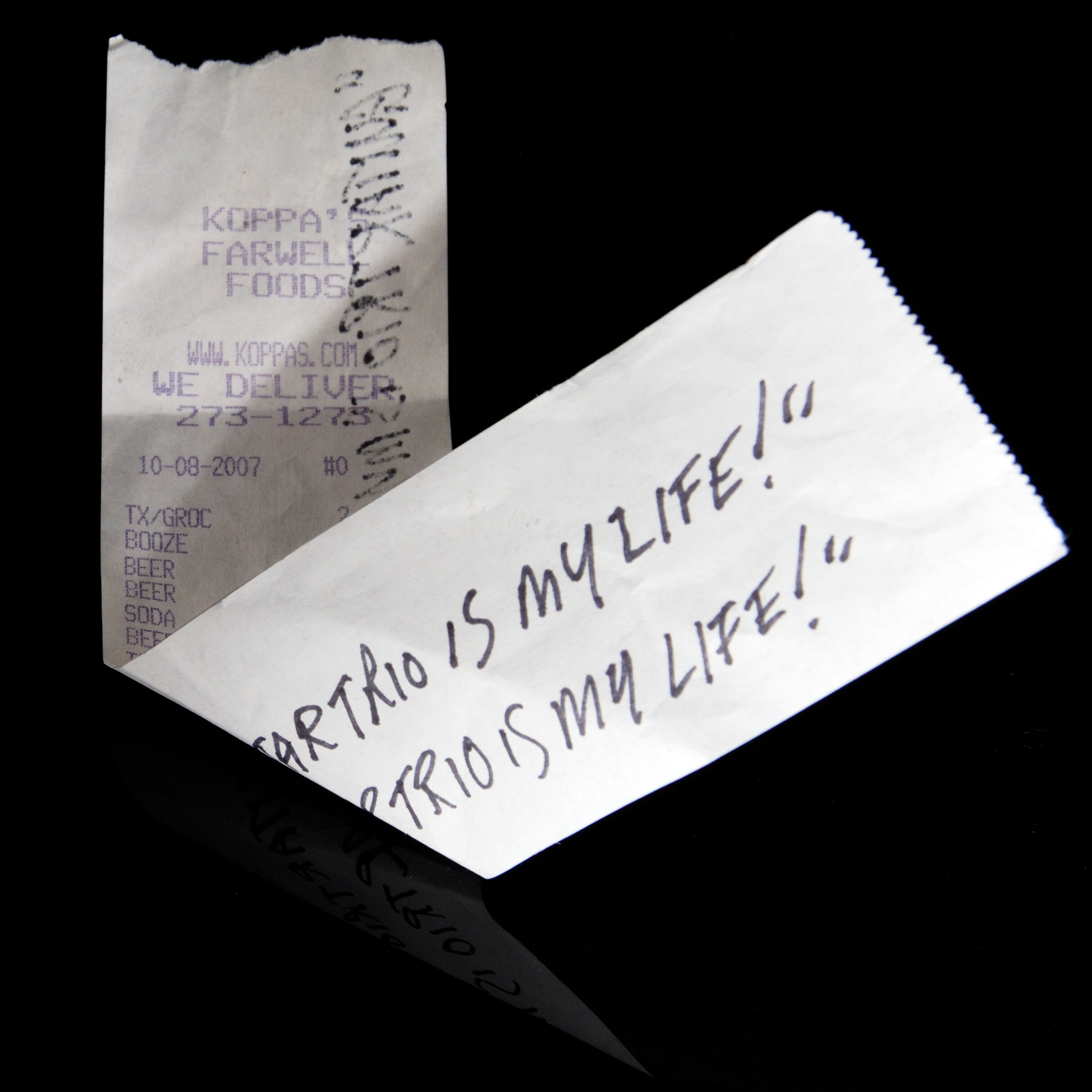
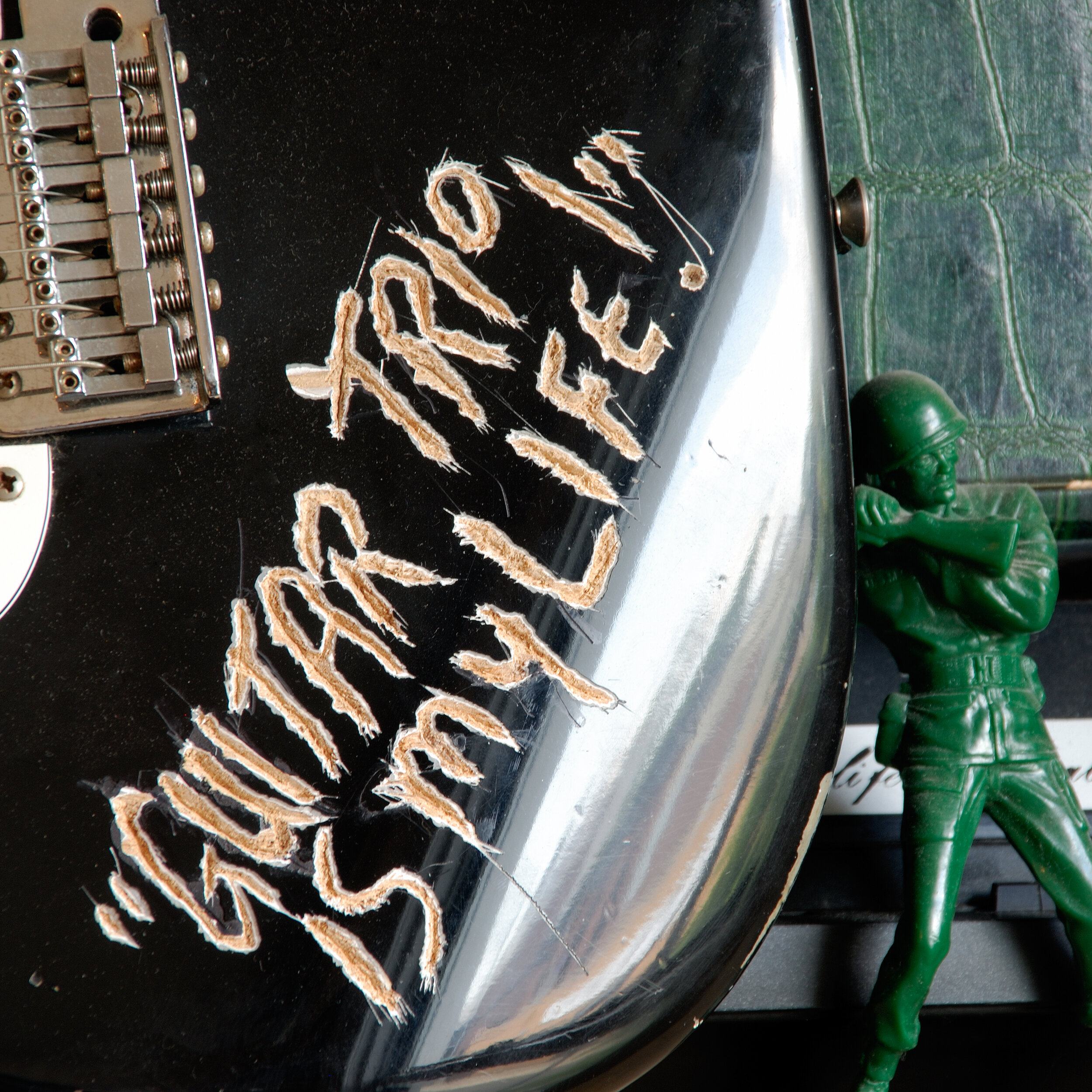
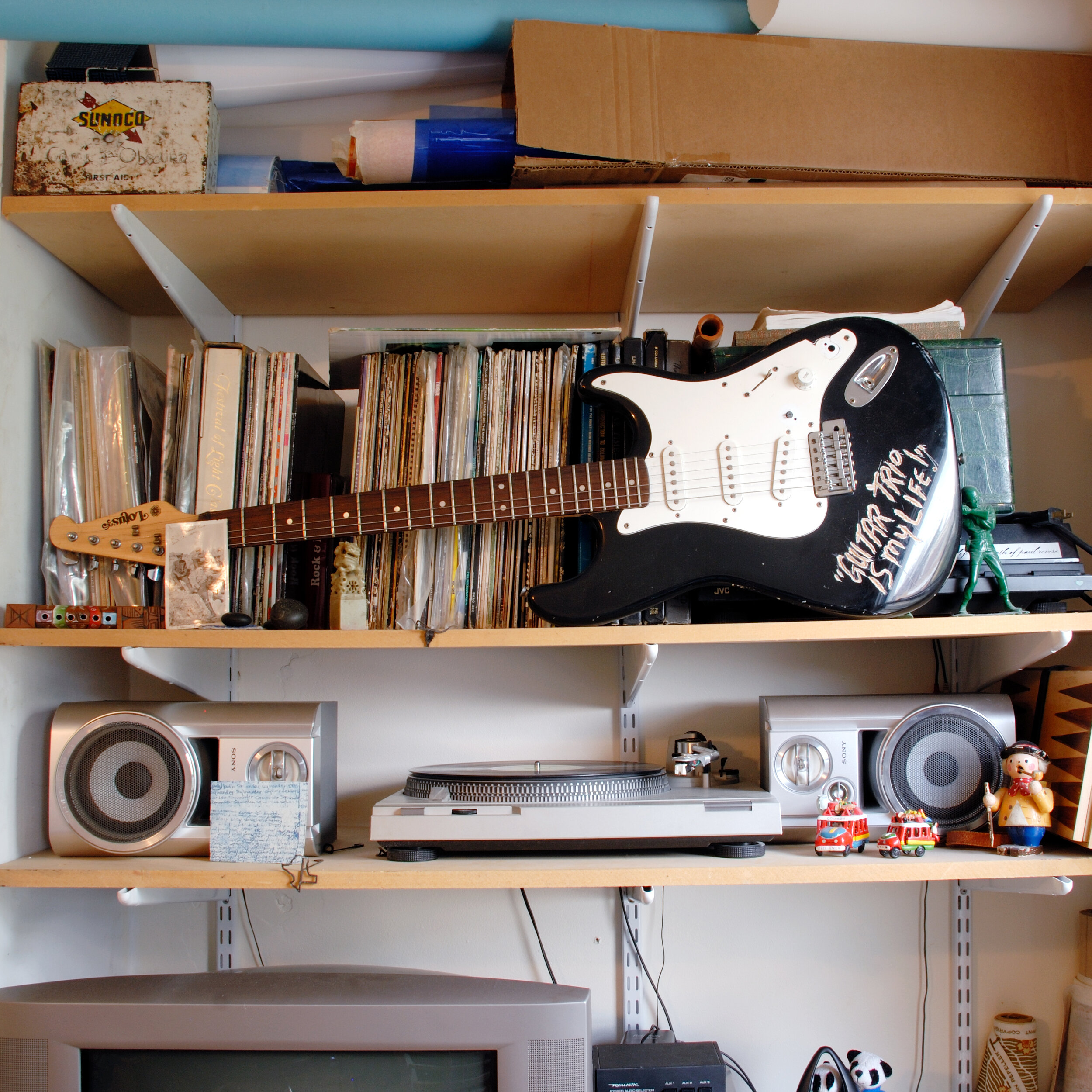
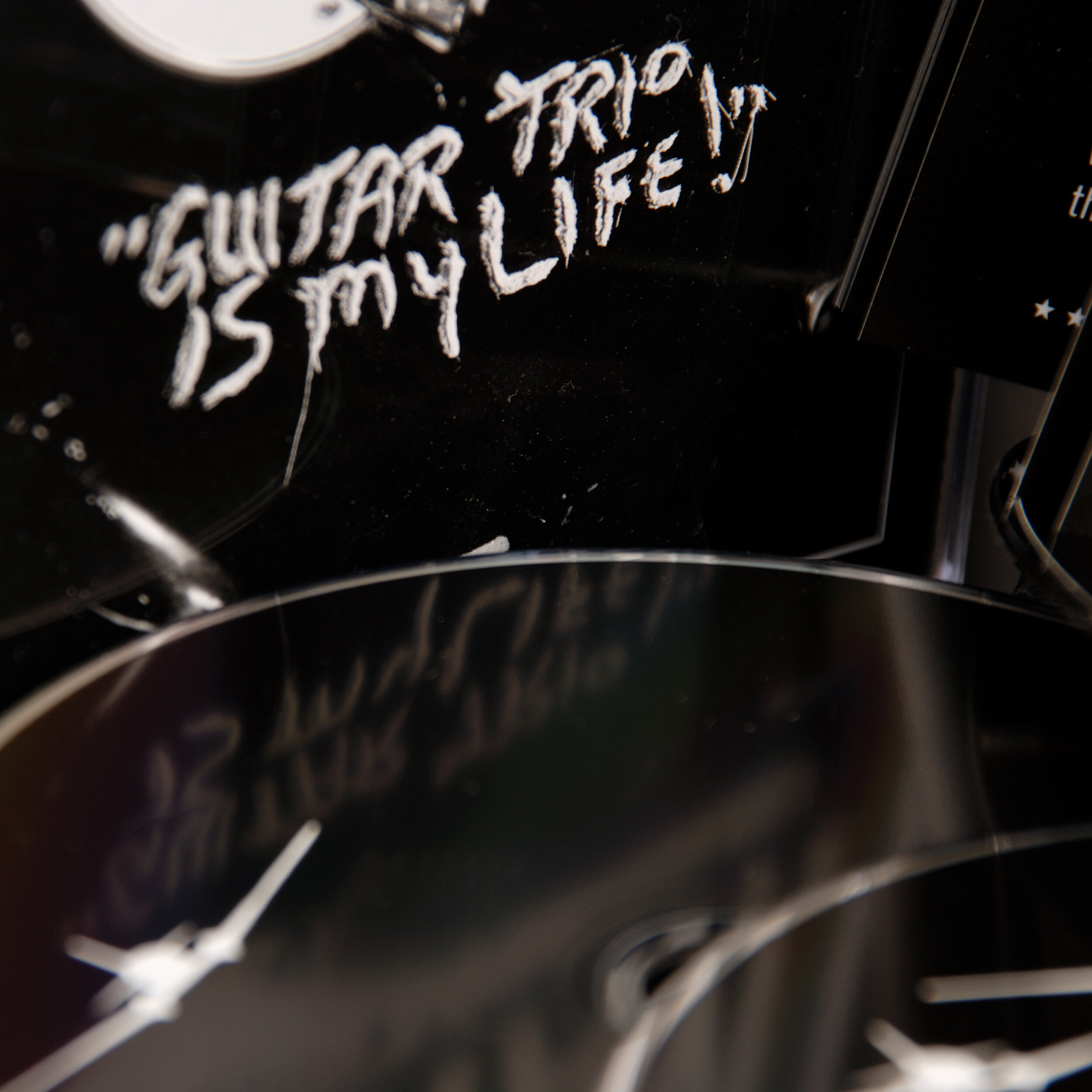
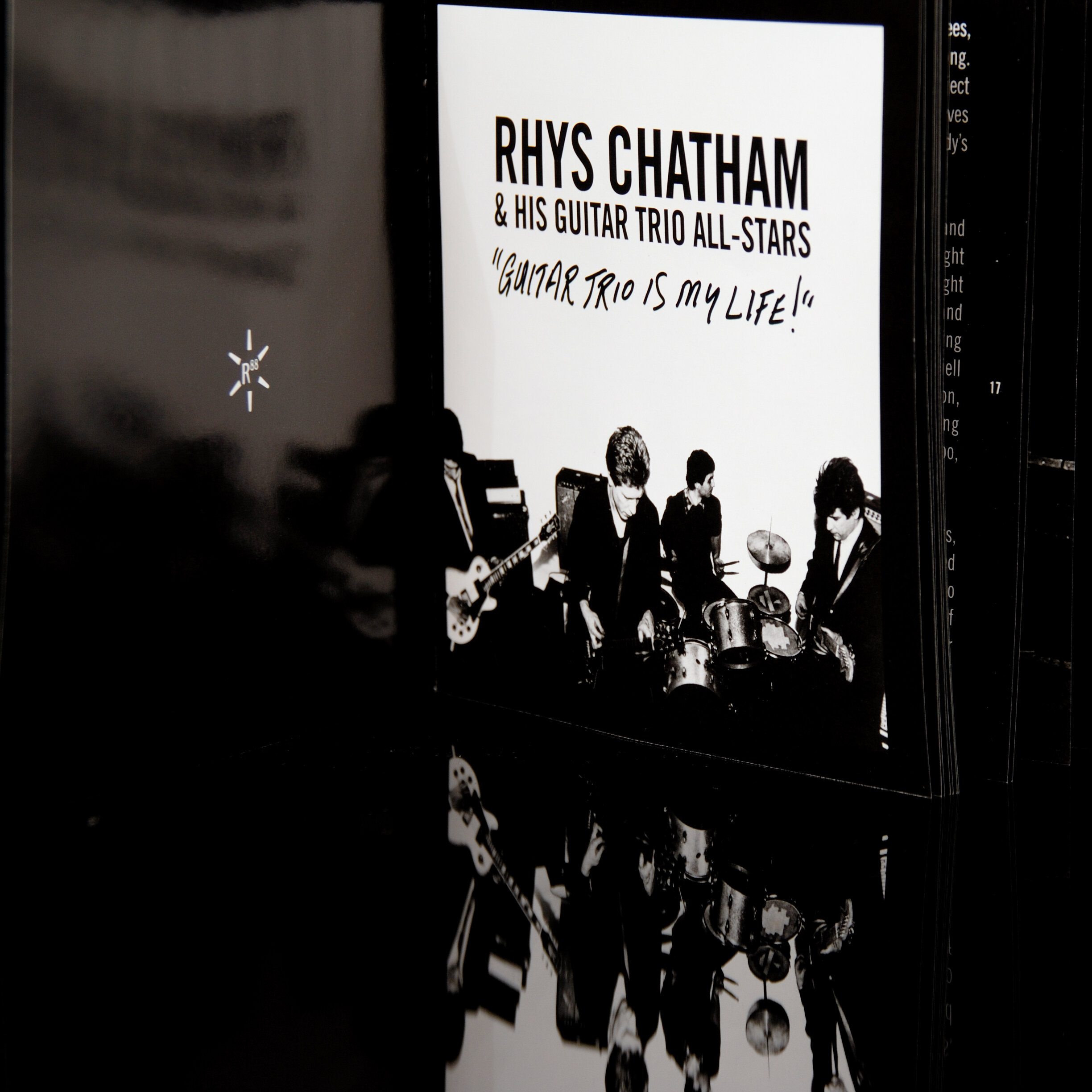
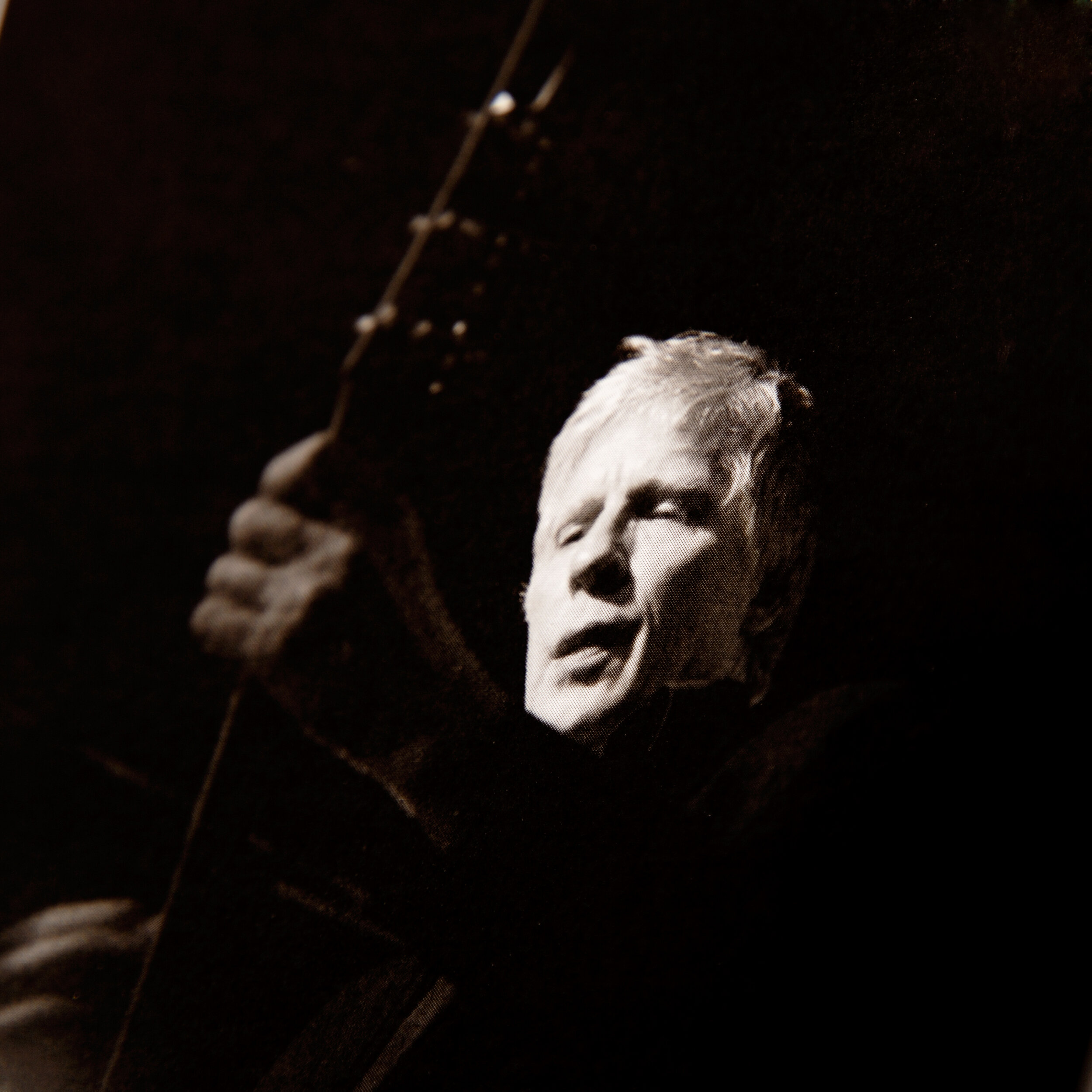
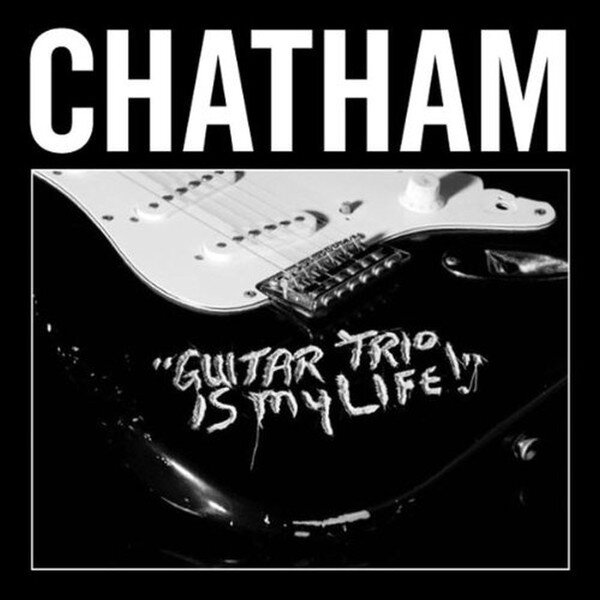
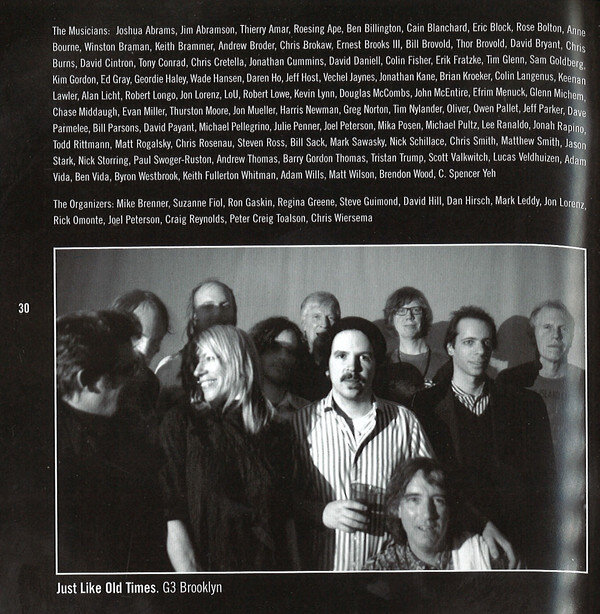
Tony Conrad Collection no. 26)
Rhys Chatham & His Guitar Trio All Stars
“GUITAR TRIO IS MY LIFE!”
2008
Radium/Table of the Elements
TOE-CD-813
3x compact discs, 48-page book
Utilizing multiple electric guitars and a single chord, 1977’s “Guitar Trio” is composer Rhys Chatham’s signature work, and a euphoric, minimal-punk classic. It’s an inspired amalgamation — the droning, shimmering harmonics of John Cale and Tony Conrad fused with the power and fury of the Ramones — that had a meteoric impact. It placed Chatham at the forefront of the burgeoning No Wave scene; its influence then spread further, as protégés and participants in Chatham’s ensembles — including Glenn Branca and members of Sonic Youth — folded the sound into their own. “Guitar Trio” remains a composition with a half-life, an adventure in sound that continues to radiate influence and inspiration.
Now, to celebrate the 30th anniversary of “Guitar Trio” on an epic scale, Chatham musters an all-star guitar army for the 3xCD set, “GUITAR TRIO IS MY LIFE!” The sprawling collection features members of Sonic Youth, Swans, Tortoise, Godspeed You! Black Emperor, Hüsker Dü, Modern Lovers, Silver Mt. Zion, Town and Country, Die Kreutzen, 90-Day Men, Collections of Colonies of Bees, and many more; even Tony Conrad gets in on the act. Together these artists celebrate Chatham’s wordless anthem, with its minimalist origins, rock & roll rhythm, ecstatic whorl of harmonics, and ever-evolving, ever-expanding nature.
So, take a listen, and hear what one man can do with hundreds of guitars, 30 years, one chord, and a skyscraper of amps set to Liquefy. “Guitar Trio” endures.
“[Rhys Chatham] is one of noise rock’s founding fathers. Without him, there would be no Sonic Youth, no Jesus and Mary Chain, no My Bloody Valentine … he remains a towering figure among six-string aficionados.”
Greg Kot, Chicago Tribune, author of Wilco: Learning How to Die
“Blue Oyster Cult and Kiss might’ve made noises about guitar armies, but it took composer Rhys Chatham to actually deploy one. And there’s no other way to say this: It rocks”
Bill Meyer, Magnet
“Surging phosphorescence … uplifting.”
David Fricke, Rolling Stone
“If you free yourself from the conventional reaction to a quantity like a million years, you free yourself a bit from the boundaries of human time. And then in a way you do not live at all, but in another way you live forever.”
John McPhee, Annals of the Former World
“GUITAR TRIO IS MY LIFE!”
That disarmingly concise personal manifesto was bellowed by a passionate, inebriated young fan at a 2006 Rhys Chatham concert in the de facto capital of rock ‘n’ roll, Cleveland. It pretty much says it all.
Written and first performed in 1977, “Guitar Trio” is, at first glance, a work for multiple electric guitars, all playing the same chord, E (well, Em7, if you want to get specific), with a special tuning of the strings, in a rhythm that vaguely resembles that of “My Baby Does the Hanky Panky” by 60s group Tommy James & the Shondells. Later versions incorporate more guitars, but the chord and rhythm remains the same. Yet Chatham’s signature work is much more than that; it’s a composition with a half-life, an adventure in sound that continues to radiate influence and inspiration 30 years after it was first performed in a New York nightclub.
Loud, raw, ecstatic New York minimalism has its source in the work of Tony Conrad and John Cale in the early 1960s. However, the original premiere of Rhys Chatham’s “Guitar Trio” is the point at which that river of sound jumped its banks and began to wind its way to the mainstream. At the time, the piece had an immediate impact; it placed Chatham at the forefront of the burgeoning No Wave scene, which blossomed in the fetid, fertile streets of the Lower East Side during the late 1970s. Its influence spread further, as protégés and members of Chatham’s ensembles folded the sound into their own. That sound continues to seep outward.
When Sonic Youth are inducted into the Rock & Roll Hall of Fame (in Cleveland, of course—and you know it’s gonna happen), listen for some G3. It’s there.
* * * * *
Sound is physics, the building blocks, supplied courtesy of the Infinite Unknowable. Music is sound built up, folded back on itself; stacked, packed, arrayed, layered, spliced, diced, origamied, beaten, caressed, wowed and wooed. And sometimes, given sufficient inspiration, music gives way to song.
Rhys Chatham has spent a lifetime sailing a sea of electromagnetic waves. He has presented his work on the steps of, and beneath the immense dome of, the basilica Sacre Coeur, one of the most prominent landmarks in Paris, conducting a choir of 400 electric guitars; he has performed, with a slightly more manageable ensemble of nine, in the humid environs of Shreveport, Louisiana, beneath the patined gaze of the ghosts of Hank Williams and Elvis Presley. He was equally at home in both locales.
Chatham was born in 1952 in Manhattan. A prodigy, he began playing the harpsichord at age 6; by his teens he was studying composition, first with electronic composer Morton Subotnic; then with minimalist La Monte Young. He was also to come into the elliptical orbit of the polymathic trickster, Tony Conrad.
Plenty has been written about the rift between the latter two, former collaborators whose subsequent aesthetic and philosophical paths would take them in directions of polar opposition. Young sought to establish a kingdom of aural and mathematical perfection; while Conrad, the creator of a highly precise performance idiom of his own, was tolerant of error, at ease with noise and grit, and enamored of mind-crushingly high volume. He also possessed an arch, mischievous sense of humor. Count Conrad as one influence on “Guitar Trio.”
During this period, Chatham’s greatest influence may have been his day job—and vice versa. In 1971, at the age of 19, he became the first music director at The Kitchen, in Greenwich Village. Originally intended as a space for the installation of video art, its curatorial mission soon expanded to include various other media, including live music. Under Chatham’s direction, The Kitchen became the great sound incubator in 1970s New York, and the list of musicians, artists and performance artists who got their start there is vast. Laurie Anderson, Cindy Sherman, Eric Bogosian, Philip Glass, Peter Greenaway and Brian Eno all passed through its doors; many of them at Rhys’s invite; all of them under the influence of his tenure. Ironically (or shrewdly), he was largely responsible for creating the scene that would soon be rapturously embracing his own work.
Then it happened. The epiphany arrived in a black leather jacket. As Chatham recalls, “Prior to 1975 I was a minimalist composer. I did concerts lasting three hours, sometimes playing one single pitch or chord on voice or through electronic means.” But he had never been to a rock concert. Ever. So, on a breezy May evening in 1976, his buddy Peter Gordon, also a composer, decided it was high time that his pal lose his aural virginity. Gordon grabbed Rhys, and together they went to the most notorious sonic brothel that ever has been, or ever will be. Chatham walked beneath the awning and through the door at 315 Bowery towards his date with destiny—and what a hot date it was. He was at CBGB, and he was about to see the Ramones.
Tommy, Johnny, Joey, Dee Dee. It was the original line-up, the first record was about to come out, and they were tight. Chatham states, “What I heard at that Ramones concert changed my life. Those guys were playing three chords, which was two more chords than I was playing, but I felt a resonance with what they were doing; they struck a deep chord in my minimalist heart.” He acquired a Fender Stratocaster the next day.
It took a year to sufficiently master the guitar and completely articulate his ideas, but a year later Chatham, the minimalist turned punk rocker, hit the stage for his first show. His music was an amalgamation: intricate and visceral; rowdy and contemplative; aggressive yet also, with its emphasis on harmonics, strangely wondrous and inspiring. Even more bizarre, it was vaguely danceable. It made him an instant hit in the downtown scene. While CBGB hosted the first tier of punk/new wave bands, such as the Ramones, Blondie, Television, and the Talking Heads, Rhys would lead another, more experimental gang of artists that included Lydia Lunch, Mars, Liquid Liquid, and DNA. They called this art/rock “No Wave,” and even Eno took note. At the forefront was the remarkable “Guitar Trio.”
In early 1979, Rhys was unknowingly presented with an opportunity to pay forward a karmic debt. A young man, new to the city, was rifling through the Village Voice on a Tuesday night, looking for something to do. Seeing the ad for a Rhys Chatham gig, he and a buddy decided to check it out. It was Lee Ranaldo’s first show, and he was floored. Years later he would describe the experience.
“There was something going on that I couldn’t put my finger on. Although the players seemed to be simply strumming, amazing things were happening in the sound field above our heads. Overtones danced all around the notes, getting more and more animated, turning into first gamelan orchestras, and then a choir of voices, ping-ponging over the minimalist low notes of the rocking chord.”
Then, the piece concluded, and the crowd went nuts. You can imagine Lee’s shock, surprise, and glee when Chatham began the next number—the first one was long enough to be a set on its own, back in the punk days—and the band launched into the exact same thing. He also observes that Rhys was staggeringly high on a bizarre mélange of drugs. (It was the 70s. Who wasn’t?) Anyway. Lee concludes, “I had never heard anything like it before, yet I’d heard it in my head forever; finally here it was in front of me.”
The double performance of “Guitar Trio” that Lee and his buddy David Linton saw that night was essentially unchanged from the original that premiered almost two years earlier. The first version had a drummer, but playing only hi-hat cymbals; the second featured full drums, plus a slowly—very slowly—lap-dissolving series of blue-tinted slide projections. These depicted a skyscraper; a woman in a bouffant with child, both shielding their eyes while looking at the sky; a man running into an alley; a Japanese Zero flying low along the beach; Pennsylvania Station; a figure walking alongside a horse, carrying a prone toddler. Their meaning is opaque, cryptic; they’re somewhat iconic, and convey a subtle melancholia. They were specifically created for the piece by one of Rhys’s friends, an unknown, struggling artist named Robert Longo.
Longo also performed as a musician in one of Chatham’s many ensembles of the late 70s and early- to mid-80s. You can assess the vivid, compelling originality of Rhys’s work by the number of artists who met him, were taught his work, performed it, then carried its influence into groups of their own. Both David Linton and Lee Ranaldo joined Rhys’s ensemble. David stayed with Rhys for years, and remains a NYC fixture. Of course Lee co-founded Sonic Youth in 1981; bandmate Thurston Moore was also a Chatham veteran. Robert Poss and Susan Stenger went on to form Band of Susans. Jonathan Kane, who enlisted with Rhys in 1981, as the groups were starting to expand into guitar armies, has gone on to serious critical acclaim with his own group, February. Later in the 80s, Page Hamilton passed through before forming the hugely popular band Helmet. Glenn Branca, who was in one of Rhys’s earliest groups, went on to emulate the massed-guitar strategies and idiosyncratic tunings, with great solemnity. It’s all cool with Rhys. To quote the Temptations, funk era: “And the band played on.”
As the 80s progressed, Chatham added more and more guitars, and his compositions became increasingly elaborate, best showcased in the ebullient, 1985 classic, “Die Donnergotter.” In 1988, he left New York, following the future ex-Mrs. Chatham to Paris, where he remains today. From there he wrote “An Angel Moves Too Fast to See.” It’s a breathtakingly rich, varied work for 100 guitars, plus bass and drums, with the latter handled by Ernie Brooks (from the original Modern Lovers) and Jonathan Kane, respectively. Together they’ve toured “Angel” around the globe, teaching it to local guitarists, then presenting it in cities and towns from Scandinavia to Montreal to the tiny, actively volcanic island of Reunion, deep in the Indian Ocean, down Madagascar way.
After his self-imposed expatriation, it would be nearly 20 years before Rhys Chatham again played his guitar-based work in his native land. But at the 2005 premiere of his composition “A Crimson Grail,” commissioned by the city of Paris, and presented to a throng of thousands, he managed to slip in a version of “Guitar Trio.” It was played by 400 guitarists and viewed on national television throughout France.
It’s hard to keep a good tune down.
* * * * *
It’s 2007. Three decades have passed since the premiere of “Guitar Trio,” and things have come full circle. Literally. Rhys Chatham stands with his back against a curved wall in a round room; next to him is an amp; in his hands, a guitar. Positioned equidistance around the wall of this peculiar setting stand nine more guitarists, and a drummer. None of them could move away from that wall if they wanted—the room is packed with people. Outside, disappointed latecomers are turned away in droves.
As Rhys glances up, he makes eye contact with the various members of his ensemble, and in doing so, looks back in time. To his far left is Lee Ranaldo, reunited with Rhys after so many years, his tousled brown mop now completely white. That’s okay; Rhys’s bright red mane has undergone a similar transformation. Also in the circle are Lee’s bandmates in Sonic Youth, Thurston Moore and Kim Gordon. To his immediate right is Robert Longo. After his stint with Rhys, Longo went on to fame and fortune as one of the most acclaimed artists to emerge from the 1980s; he even directed feature films. But here he is, guitar slung low, wearing what looks to be the same black suit he wore on stage with Rhys 30 years ago, playing for beer like the rest. Long-time 80s and 90s lieutenants Ernie Books and Jonathan Kane are there, too, Ernie also going white.
There are also some younger faces, more recent initiates to the Chatham circle. David Daniell, Rhys’s new right-hand man is there; so is Daniell’s young friend Adam Wills. Wills is positioned next to Lee, and in many ways he mirrors him. As Lee was once, Adam is known only in New York, where he is known well, for his bass playing in Jonathan Kane’s band, and his guitar heroism in Bear in Heaven. He’s taking it all in stride, Lee on his left, Kim on his right. Maybe he’s scared witless, but you wouldn’t know by looking. Also present are Colin Langerius, from USA Is a Monster, Byron Westbrook, of Corridors, and the multi-talented author and composer Alan Licht. They fidget with gear.
The venue is an old oil silo set alongside the Gowanus Canal in Brooklyn. The entire legality of this event is dubious at best. The sole commode continues to disgorge its contents on to the floor. A few months ago, Rhys was performing inside the largest cathedral in France. This really is like old times, but no matter: It’s show time.
The lights dim. Jonathan counts off, the ritual invocation of rock. Rhys drops his hand, and he sounds that chord. It’s slightly sinister at first, alone, like a burglar sneaking into the room. Slowly, the others join in, one at a time, subtly, stealthily. The guitars and bass keep the rhythm. The volume increases, the tension turns slowly to joy. Harmonic overtones blossom in the air, every spare bit of oxygen rings like church bells. This being the first go-around, Jonathan is restricted to hi-hat. You can tell it’s killing him, but if he’s going to only play hi-hat, he’s going to play it like no one’s ever played it before. Metallic staccato beats zip around the room like bullets on Omaha Beach. Louder, louder, louder. Euphoria. One chord, 30 years. “Guitar Trio” lives.
This is the first show of a US tour. The tour is named “Guitar Trio Is My Life!” as a nod to that kid from Cleveland, and for the next few weeks it will snake its way through New England, Canada, and the Midwest. The band is trumpeted as “The Guitar Trio All-Stars,” but only Rhys and David Daniell are permanent members. The other nine musicians are recruited locally. Rhys will teach them the piece during sound check, then away they go. There will be some variance—in Toronto there will be even more guitar players, plus a string section—but mostly the arrangement will resemble that of New York.
The musicians are labeled “All-Stars,” and many of them will hail from prominent bands. Rhys will be joined by members of Tortoise, God Speed You Black Emperor, Husker Du, Brokeback, Lichens, Town and Country, Die Kruetzen, Bird Show and more; even Rhys’s old buddy Tony Conrad grabs an axe and gets in on the act. However just as many will not be bright lights in the indie-rock firmament; some will be guys and gals from local bands who will never make a record or achieve even relative, regional fame. However, for one night they’re all on stage together, wallowing in shimmering nebulae of sound, stars all.
Listening to recordings of the tour, it is remarkable to hear the variety in the performances. A composition comprised of a single chord? On paper it sounds like abject formalism, probably boring, and possibly an exercise in mild sadomasochism. In live performance, it is a wildly undulating ride, the guitars chafing at the bit, a galloping team ready to bolt, barely under rein. It is controlled chaos, and frankly has as much in common with free-improvisation as it does with minimalism. The inverted structure—the guitars are the rhythm section; the bass and drums run amok; above it all, the whorl of harmonics—guarantees an infinite variety of interpretations. Yet it always seems to work. It’s like Lee says. You can’t put your finger on it, but there’s something about it that speaks to you.
By now it’s a miracle that Jonathan hasn’t cracked the hi-hat cymbals. He’s a dervish, a blur, and the circle of guitarists is following his lead, having completely abandoned the original rhythm in order to play as fast as humanly possible. The crescendo complete, the musicians are no longer playing, but the air remains thick with sound. Cheers immediately follow.
As the applause begins to wane, the stage lights dim, and a luminous blue glow fills the room. A skyscraper appears. The applause doubles, quadruples. Jonathan counts down and Lee, reflecting back to a moment that so shocked and thrilled him decades earlier, once again summons The Chord.
The second version doubles the ferocity of the first. Now unleashed, Jonathan is an animal, a magnificent beast. Whatever self-doubt Adam might have had was unfounded; he rocks, as well as anyone in the group, possibly more. A light pours out of Rhys.
When it’s over, and the applause finally dissipates, everyone in the room recognizes they’ve participated in something special.
* * * * *
Music is as fundamentally Human as it gets. Since we first climbed out of the trees, it's been our mating call. Add language and you’ve got our collective codex: song. In song we express our fears and hopes; we share our lusts and desires; we project our anger and boast of our courage; we console each other, and we get ourselves riled up. We celebrate our God. We profess our loves. One way or another, everybody's got a song to sing.
There's a video clip making the rounds on YouTube. Check it out. It's Rhys and the G3 gang on stage in Milwaukee. It's the end of the last set, on the last night of the tour. The stage is enormous, the biggest of the tour by far, but tonight it's not nearly big enough for these guys. They are pummeling the piece, and the stage, and themselves: jumping, leaping, rolling on the ground, writhing on their backs; colliding, staggering, colliding again. Even bandleader Daniell drops his usually stern visage and joins in, laughing. It's maniacal abandon, a romp, and Rhys is right in the thick of it, dropping to his knees and rocking out with his guitar, just like Chuck Berry or Pete Townsend. The crowd, too, is ecstatic.
Rhys Chatham has spent his entire life in the company of musicians, writers, artists, dancers, and poets. They are drawn to him and he to them. He has crafted magnificent works that will outlive their creator, and a legacy that will continue to inspire others. While he wishes it were otherwise, he'll only be able to meet a few of the fans who pack the clubs and halls to see these shows. Yet when they stagger home, inspired, some of these kids will vow to make music on their own. A few of them will do it. And maybe one or two of them will immerse themselves in music for life. Like Rhys has.
No longer the teenage wunderkind who led the New York avant-garde into battle against the Hoards of the Age of Aquarius, this Rhys Chatham is 54, floating inexorably towards the far side of middle age. Presumably he endures the same bevy of mundane annoyances as other folks: medical issues, problematic relationships, unpaid bills; uncertainty, regret, malaise. Tonight, none of that exists. Look at his face. He's beaming. He's having a blast. Tonight, in Wisconsin, USA, Rhys Chatham is a rock star, and he knows it, and he's doing exactly what he wants to do.
Pause the clip.
What if we could intrude in the moment? Rhys Chatham has been devoted to a wordless anthem for 30 years. What is it, exactly, that “Guitar Trio” conveys so effectively, with its minimalist origins, rock & roll rhythm, shimmering, ecstatic harmonics, and fluid, ever-evolving, ever-expanding nature? Why does it resonate, generation after generation? What simple, human fundamental does this bit of music communicate about Rhys himself? What if we could go back to that night in Wisconsin, stop the clock as we have now, and ask him?
No need: Look at his face again. Bliss. There’s your answer, simple and obvious. Rhys Chatham is singing his song. “Guitar Trio” is a serenade, a love song to sound itself, from a man whose entire life has been a rhapsody, a bending and a blending of forms and genres. Losing himself within the embrace of sound is his passion, and with “Guitar Trio,” he allows you to share his infatuation, and indulge your own, too. See the exuberance in all those boys on stage, frozen in a mid-tumble blur of beard, denim, guitar, and western-wear shirttail? They’re also in love with sound. That’s okay; there’s plenty to go around.
Sound goes low, deep to the core of the Earth. It goes high, too: higher than we can tolerate, then higher than we can hear, then higher than any living creature can hear. It goes higher and higher and higher still, until it rains down as sunlight and collects in pools as all the colors of the spectrum. Feel lucky? Reach out and grab just enough to make a single chord. Who knows? It might even be enough for a song.
* * * * *
So there you go. Take a listen, and hear what one man can do with hundreds of guitars, thirty years, one chord, and a skyscraper of amps set to "Liquefy."
"Guitar Trio" endures.
Oh, and go ahead, hit Play, and watch the rest of that YouTube clip. As with life in general, the quality sometimes sucks, but it's the spirit of the thing that matters.
One more thing. Anonymous Cleveland dude?
This chord's for you.
Jeff Hunt
Milwaukee, Wisconsin
August 2007
If the most pure rock'n'roll is all about excess, emancipation, and sexuality, then 55-year-old Parisian composer Rhys Chatham makes Mick Jagger seem like a Sunday school teacher: Chatham's second 3xCD box set for Table of the Elements, Guitar Trio is My Life!, collects 10 performances from Chatham's 2007 14-city North American tour. Every night, Chatham and a different ensemble of musicians performed his most famous work, 1977's "Guitar Trio", twice. It's about time: For too long, Chatham's massed guitars have been a footnote to those of the more famous Glenn Branca. But Branca--- like Sonic Youth's Lee Ranaldo and Thurston Moore, Swans' Michael Gira and Jonathan Kane, and the Modern Lovers' Ernie Brooks, many of whom appear here-- was an early student of and member in Chatham's New York ensembles. This exhausting, exhilarating collection, though, should confirm both Chatham and "Guitar Trio" as staples in the rock and 20th cenury composition canons. At the very least, from the first E note to the last E chord three hours later, it proves that Chatham-- also significant for his curatorial role at New York's The Kitchen in the 70s and in the establishment of No Wave later that decade-- fucking rocks.
The "Guitar Trio" score is deceptively simple: "In this century, it has never taken more than an hour to teach 'Guitar Trio' to everyone's satisfaction and comfort level," Chatham wrote in the score notes circulated for the 2007 tour documented by Guitar Trio Is My Life! "So please don't worry about anything." Several guitar players gather around a drummer and an electric bassist. Their amps are clean, loud, and high on treble. The drummer counts off, and Chatham strums an open low E string, his rhythm a bit like a jumpy 60s Brit Invasion tune. The drummer plays a cantering, steady rhythm restricted to the hi-hat. One by one, Chatham signals each guitarist to join. The bassist enters. After several minutes, Chatham begins strumming the top three strings and then signals each guitarist to do the same. Later, Chatham begins strumming all six strings, fretting only the second string to B. Eventually everyone stops playing except the drummer, still using only hi-hat, and Chatham, again playing one string. The entire process repeats, and it's generally a bit briefer the second time around. The music fades out with a final chord played on a conclusive downbeat. Chatham announces the ensemble, bows, turns to his band, and starts again in the exact same way. Except this time, the drummer is given use of his full kit, especially the snare and kick drums. The only previous version of "Guitar Trio" (available on the long-since out-of-print 2002 box set An Angel Moves Too Fast to See and on the 2006 disc Die Donnergötter) was eight minutes long (first cycle only). The shortest take on Guitar Trio Is My Life! is the second Brooklyn cycle, which ends after 16 driving minutes.
But the "Guitar Trio" sound is surprisingly dynamic: Chatham does not specify when any given player should play above any given fret or for what length of time. Such inherent indeterminacy means that what begins as a stately, strummed guitar pattern begins to mutate and grow into surprising shapes. This variety of sounds builds cumulatively into a thick swath of high and low overtones bouncing off of each other like long-lost kin at a crowded family reunion. All of the sounds are made from the same E string or E chord, but none of them are exactly the same. By the time "Guitar Trio" hits its six-string segment, it's as thick as a furious blizzard. When the notes really come down, it's beautiful and overwhelming.
Still, 10 versions of the same 16-to-30 minute piece of music? Boring, right? Perhaps were it not for the musicians included here-- from members of Tortoise, Sonic Youth, and Thee Silver Mt. Zion to an unknown but incredible Buffalo drummer named Jim Abramson, who gloriously mauls his 21 minutes of Table of the Elements time on Disc One. "Guitar Trio" ingests individual talents and funnels them into a composition loose enough for new ideas but tough enough to test physical and mental limits: On the full-drum version from Toronto, then, you get a six-piece string section (including Final Fantasy's Owen Pallet), thickening the guitar sound into a viscous smear. But after the one-string turnaround, it sounds like Chatham's worn them out. Same for Tortoise's John McEntire, who turns in the best brass-only drumming with his Chicago performance, riding his hi-hat with impeccable time and finesse. But he gets lost inside the nine-guitar storm on the full-kit version, unlike improvisational heavyweight and Collections of Colonies of Bees drummer Jon Mueller. Like he does on this year's solo drum Table of the Elements release Metals, Mueller rattles speakers from the frame. His kick drum and heavy snare slap fearlessly. They lash at the six guitars like the only way out is revenge. Same for Ernie Brooks' bristling bass pops on the second set from Brooklyn: With a rhythmic sense that sounds like whiplash must feel, he folds his own aesthetic beneath Chatham's masterful umbrella work.
When considered alongside Chatham's statement that he can teach anyone this piece in an hour, such variety is exhilarating. "Guitar Trio" was composed after Chatham, then a New York composer taking a somewhat academic approach to minimalism, saw the Ramones play CBGB. Their music shocked him into redirecting his sonic approach within his own pre-existing ideas. The result is glorious, one-chord, electro-orchestral, garage-band minimalism. Anyone can learn this music. Anyone can play this music. Anyone can enjoy this music, rhythmically and tonally electrified as it is. This is a popular inroad for both understanding and participating in sound fields generally relegated to academia. "Guitar Trio" suggests infinite possibilities for this music, for all music, really: If you can combine basic "punk" ideas with basic "classical" ideas to create something that will forever alter the shape of both memes (see Sonic Youth and Glenn Branca), what can't you do?
Grayson Currin
Pitchfork Media
Tony Conrad Collection no. 27)
various artists
Table of the Elements Postage Stamps
2004
Table of the Elements
TOE-PRM-3 (promotional only)
Vellum, paper, board, pin perforation, gum adhesive, metallic ink

